How to Travel From Venice to Florence by Train, Bus, Car, and Plane
:max_bytes(150000):strip_icc():format(webp)/james-globe-56a3a1c05f9b58b7d0d2e4e5.jpg)
Venice and Florence are two of the most popular cities to visit in Italy, one for its picturesque canals and the other for its Renaissance art and architecture. The two tourist-centric destinations, separated by about 258 kilometers (160 miles), are connected by a fast and efficient rail service and the famous autostrada , where it's perfectly acceptable to drive at 130 kilometers (80 miles) per hour . It would take about three hours to drive it, but that's not counting the time you'll want to spend in places like Padua , Ferrara , and Bologna along the way. Flying takes about the same amount of time, but it's expensive and there are no direct routes. The two-hour train is a popular transportation option and there's a bus for the budget-conscious, too.

What Is the Cheapest Way to Get From Venice to Florence?
The bus makes it easy to adhere to a budget whilst traveling through the Italian countryside. FlixBus departs several times a day from the Venetian island of Tronchetto (which you may have to ferry to for $9 and 20 minutes of your time). The most direct route takes just over three hours to get to Florence's Piazzale Montelungo, but longer trips can take more than seven hours and require messy transfers. Tickets start around $10. Considering the minimal price difference between taking the bus and the train (a much faster journey)—which can be bridged by that ferry ticket to Tronchetto anyway—most people choose to travel by rail instead.
What Is the Fastest Way to Get From Venice to Florence?
The high-speed train between Venice's Santa Lucia station and Florence's Firenze Santa Maria Novella station takes a mere two hours (sometimes more, sometimes less), making it even faster than driving (especially when you factor in the train's city center-to-city center service). Between the two available services—Trenitalia Frecce and ItaloTreno—trains depart every hour and a half between 7 a.m. and 4 p.m. Tickets start at around $20 and can be booked via Rail Europe .
How Long Does It Take to Drive?
Driving can easily wind up being the most expensive transportation option—what with the cost of parking, fuel, and renting a car, if necessary—but it offers the most potential for adventure along the way. The most direct route between Venice and Florence is the autostrada (highways A13 and E35, specifically), which is a 257-kilometer (160-mile) route that takes about three hours of driving time.
How Long Is the Flight?
There are no airlines that fly directly between Venice and Florence , but Italy's flag carrier Alitalia offers frequent flights to and from both destinations, stopping in Rome. The flight to Rome from Venice Marco Polo is about an hour and 10 minutes, then from Rome to Florence is another 55 minutes. The layover at Rome Fiumicino typically lasts about an hour, too, making the entire journey about three hours (as long as it would take to drive). The real downfall is the price: Tickets start around $286. Florence has only one airport and it's about a 15-minute drive from the center.
When Is the Best Time to Travel to Florence?
The best time to travel to Florence from Venice is before or after the summer high season, when transportation will be booked up and, therefore, most expensive. April, September, and October tend to be quiet and cheap times to travel while still offering mild weather and tourist-centric activities. Book your train ticket well in advance (up to 60 days) for the lowest price. Otherwise, if you're traveling on short notice, it's recommended to opt for off-peak trains, which Rail Europe says are "more affordable than morning and evening trains along with those running on holiday eves, Friday, and Sunday afternoon."
What’s the Most Scenic Route to Florence?
If you're looking to see some authentic Italian countryside along the route, take Po Valley, the country's agricultural heartland, instead of the autostrada. This route, running between Verona and Parma, is a short detour adding about 150 kilometers (93 miles) and an hour and a half onto the trip. On the upside, though, you won't pass any tolls and you'll be treated to some marvelous natural scenery along the way. If you'd still rather take the autostrada, then be sure to make pit stops in historic Padua, artsy Ferrara, and the culinary haven of Bologna for some Tagliatelle al Ragu.
Can I Use Public Transportation to Travel From the Airport?
The easiest and cheapest way to get to the city center from the Florence Peretola Airport is by tram. The Tramvia line T1 connects the airport to Santa Maria Novella (SMN)—Florence's centerpiece—in about 15 minutes and for about $1.63 per ticket. You can purchase tickets at the station, which is located just outside of baggage claim. Alternatively, you can take the Volainbus , a special bus shuttle that goes to SMN, but it takes slightly longer (around 20 minutes) and costs more ($6.50), too.
What Is There to Do in Florence?
Florence was once one of the wealthiest European cities during medieval times (earning the nickname "the Athens of the Middle Ages") and you can still tell it today just by looking at the richness of its Renaissance-era architecture and monuments. The famous Uffizi Gallery—housing works by Raphael, Michelangelo, Da Vinci, and Botticelli—is a good representation of this, as is every building you'll see as you stroll through the city. Sitting at the heart of Tuscany , Florence is also known for its wine and food. You will find it tough to resist the olives and Chianti on every menu.
Venice and Florence are 258 kilometers (160 miles) apart.
The most direct route is the autostrada (highways A13 and E35, specifically), which will take about three hours.
The high-speed train between Venice's Santa Lucia station and Florence's Firenze Santa Maria Novella station takes two hours. Tickets start at around $20.
How to Travel From Rome to the Amalfi Coast by Train, Bus, and Car
How to Travel from Rome to Milan by Train, Bus, Car, and Plane
How to Travel From Rome to Venice by Train, Bus, Car, and Plane
How to Travel From Amsterdam to Venice by Train, Bus, Car, and Plane
How to Travel From Milan to Venice by Train, Bus, and Car
How to Travel From Rome to Paris by Train, Bus, Car, and Plane
How to Travel from Rome to Florence by Train, Bus, Car, and Plane
How to Travel From Barcelona to Toulouse by Train, Bus, Car, and Plane
How to Travel From London to Carlisle by Train, Bus, Car, and Plane
How to Travel From Florence to Paris by Train, Bus, Plane, and Car
Your Trip to Florence: The Complete Guide
How to Travel from Venice to Athens by Plane, Ferry, and Cruise
How to Travel from Rome to the Cinque Terre by Train, Bus, Car, and Plane
Florence Italy Travel Guide
How to Travel From Rome to Naples by Train, Plane, Bus, or Car
The 14 Best Day Trips from Rome

From Venice to Florence: 5 Best Ways to Get There
Written by Shandley McMurray Jun 16, 2023 We may earn a commission from affiliate links ( )
Venice and Florence are must-visit destinations on any Italian itinerary . The fact that they lie 269 kilometers from each other makes it easy to see both cities in one trip, especially when there are so many convenient ways to travel between the two.
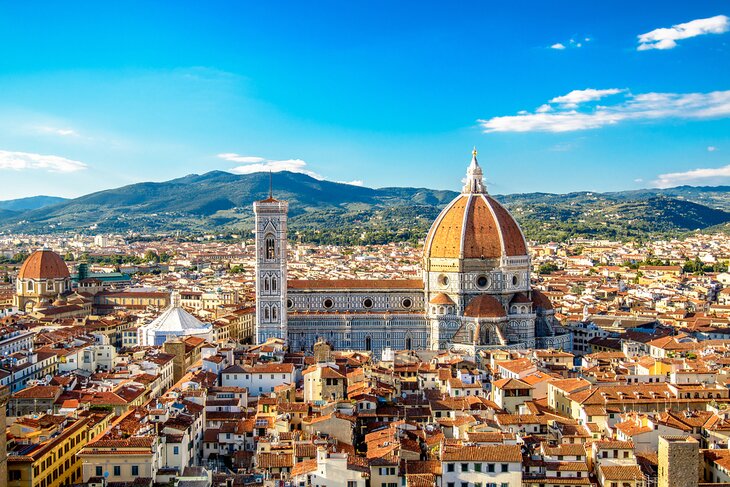
Traveling from the sparkling canals and captivating attractions of Venice to the unmissable museums and beautiful churches of Florence is easy if you take the train. The fastest way to get from Venice to Florence, high-speed Frecciarossa trains can reach the Tuscan capital in two hours and 13 minutes .
Other ways to reach Florence include booking a private transfer and driving yourself, which could be a bit stressful if you're unfamiliar with Italian roads. Taking the bus and flying are also popular ways to get around.
No matter which way you choose to travel, use our list of the best ways to get from Venice to Florence.
On This Page:
- From Venice to Florence by Train
- From Venice to Florence by Private Transfer
- From Venice to Florence by Car
- From Venice to Florence by Bus
- From Venice to Florence by Plane
1. From Venice to Florence by Train
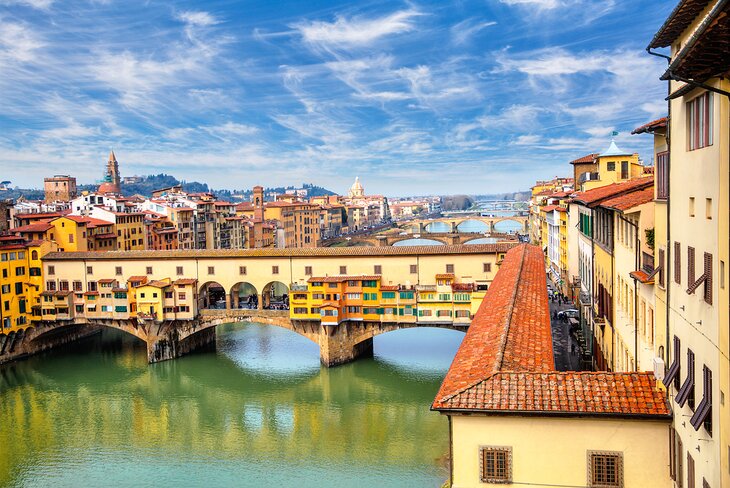
The fastest and easiest way to get from Venice to Florence is by train . Climbing aboard a Trenitalia high-speed Frecciarossa train is the best way to travel. Reaching high speeds of 300 kilometers an hour, they can zip between Venice Santa Lucia and Florence Santa Maria Novella stations in two hours and 13 minutes .
The Frecciarossa 1000 is even faster , reaching speeds of up to 400 kilometers an hour. A journey on this speedy train will get you to Florence in under two hours . Tickets on Frecciarossa trains will cost about $43 one-way for a standard fare and over $154 for Executive class.
These trains run multiple times a day (nearly every hour) and boast air-conditioning, power outlets, free Wi-Fi, and access to a café car.
Another high-speed option can be found on trains with Italo Tren . Their quick trains run between Venice Santa Lucia and Florence Santa Maria Novella in two hours and 15 minutes. They also operate trains between Venice Mestre station and Florence Santa Maria Novella in just over two hours .
Tickets cost as low as $14 depending on the time, date, and class you choose.
Trenitalia also offers Intercity trains , which are much slower and similarly priced to their faster Frecciarossa counterparts. They only reach a top speed of 200 kilometers an hour and operate as local trains, making more stops along the route.
On average, these trains will take about three hours and 14 minutes to arrive in Florence Santa Maria Novella. Tickets cost about $14 or more than $43 for a First-Class fare. Our suggestion: opt for the faster trains, there's really no downside.
2. From Venice to Florence by Private Transfer
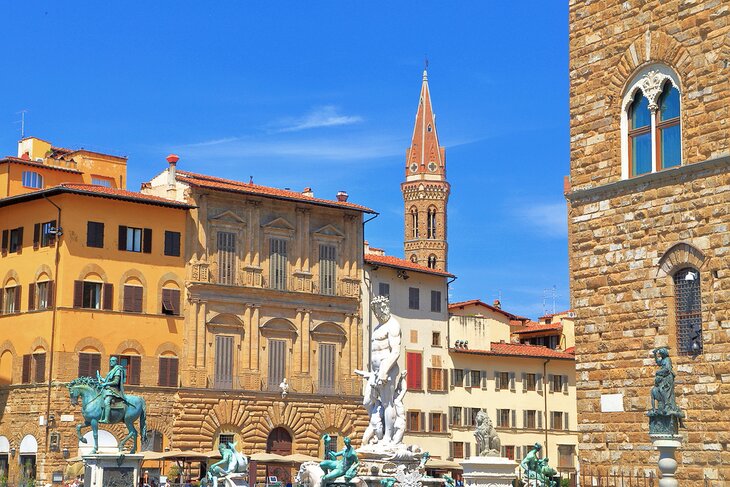
A stress-free way to get from Venice to Florence is by private transfer . If you're traveling with a small group, this is also a budget-friendly way to travel. Booking a private transfer with a personal chauffeur means you'll get from point A to point B without the hassle of dealing with public transportation.
An English-speaking driver will collect you and your travel partners from Piazzale Roma. They will then transport you in an air-conditioned vehicle to Florence, making stops as requested along the way. There's also bottled water provided in the car and Wi-Fi.
For an extra fee, you can request a longer stop in towns like Bologna , Ferrara , or the Barberino Outlet . After that, the driver will take you to your hotel or other accommodation in Florence. The drive, without stops, will take between three and four hours, depending on traffic.
3. From Venice to Florence by Car
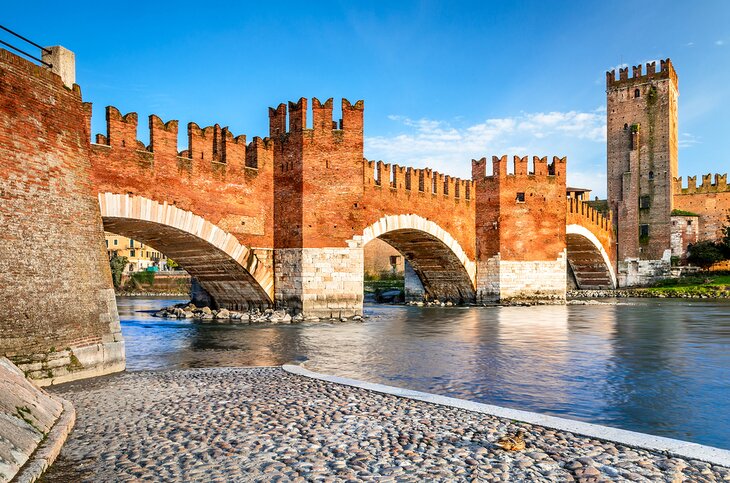
If you feel comfortable navigating twisty roads peppered with drivers who treat them like an F1 track, hit the road! Driving is an easy and scenic way to get from Venice to Florence . The most direct route can cover the 269 kilometers between these two major Italian cities in over three hours .
If you're traveling in summer, prepare to add a minimum of one hour to this estimate—the traffic is horrendous, especially on weekends. If you're not in a hurry, perfect! We suggest stopping in at least two of Italy's most beautiful cities on your road trip.
Verona is most famous as home to Juliet's balcony (yes, that Juliet). A popular day trip destination , it lies a mere 121 kilometers west of Venice, which will take about an hour and a half to drive. There are enough fun things to do in this quaint town that you'll want to factor in at least two hours to explore.
Your next stop should include the buzzing town of Bologna , which is an ideal place for a day trip from Florence . Located 117 kilometers north of Florence , it lies under two hours away and boasts enough interesting tourist attractions that you'll want to carve out a few hours for this road-trip stop .
The direct route follows the A1 Autostrada, also known as the E35, and the A13 for much of the journey.
Insider's tip: Keep cash or a debit/credit card at hand to pay for the toll roads.
Renting a car in Venice is a cinch . Companies like Europcar , Sixt , and Hertz boast multiple pickup locations, including convenient spots by the Venice Mestre train station.
4. From Venice to Florence by Bus
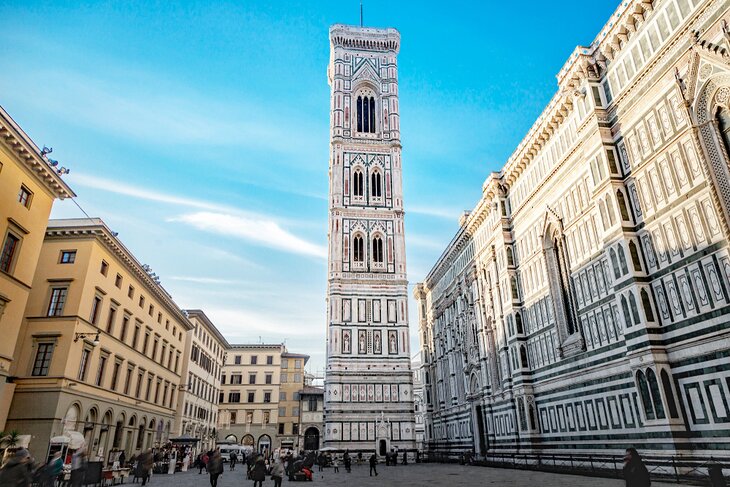
Cash-strapped travelers will be happy to know that taking the bus is the cheapest way to get from Venice to Florence . Tickets can cost as little as $4.99 depending on which company, route, date, and time you choose to travel.
Flixbus offers affordable rates on their routes, which run from Venice Tronchetto (a 12-minute drive from Venice Mestre train station) to Florenz Villa Costanza (a 17-minute drive from Florence Santa Maria Novella station). Buses also depart from Venice Mestre station many times a day beginning at 12:50 am and ending at 9:15 pm.
Depending on traffic, the ride will take about three hours and 50 minutes from Venice Mestre station to Florenz Villa Costanza, which lies just outside the city. Tickets cost as little as $4.99 and many are direct trips. The buses are air-conditioned and offer free Wi-Fi and power outlets.
Itabus is another budget-friendly company offering trips from Venice to Florence for as little as $13. Buses leave from Venice Tronchetto and Mestre stations and arrive at Florence Villa Costanza between three hours and 20 minutes and four hours and 25 minutes later, depending on the route, date, and time.
Itabuses run these routes from 7:50 am to 10:25 pm. They feature reclining seats, power outlets, and a double armrest. They also boast air-conditioning and free Wi-Fi.
5. From Venice to Florence by Plane
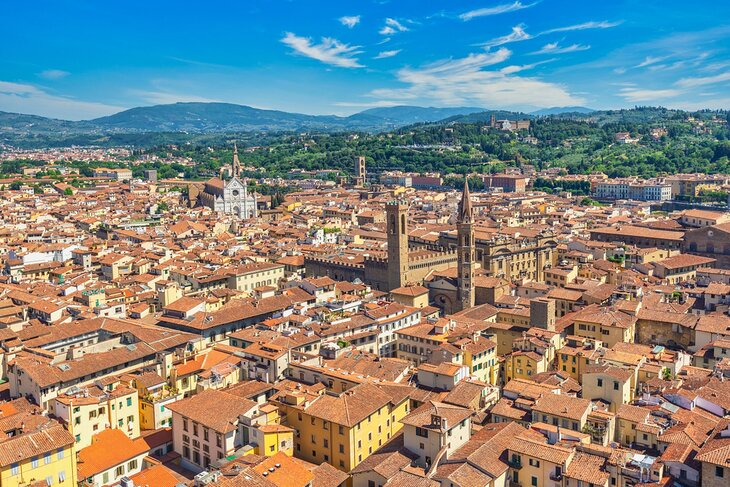
If you prefer to take to the skies when traveling throughout Italy, flying is a somewhat convenient way to get from Venice to Florence . ITA Airways offers multiple flights a day from Venice's Marco Polo airport to Florence's airport best known as Peretola.
While the flights aren't direct (most stop for over an hour in Rome), they'll still get you there in about three and a half hours . Economy class tickets will cost about $160 for a return trip, more than $240 if you choose superior class.
After landing, you'll have to get to your hotel or other destination in Florence. While taking a taxi is easy, the T2 Vespucci line of Tramvia GEST is a two-minute walk from the arrivals and departures areas of Terminal 2 and the tram arrives at Florence's center in 20 minutes. Tickets cost about $1.70 and can be purchased from machines at all tramway stops or on the TABNET app on a smartphone.

More on Italy

The Florence Insider
Your guide to travel and experience Florence, Italy
Going from Florence to Venice: guide to transportation
Most travelers visiting Italy for the first time stop in Florence and Venice. After all, they are two unique cities in the world, and among the richest in art and history in Italy. If you’ve ended up here you’re probably wondering, like many others, how to get from Florence to Venice (and vice versa) . Don’t worry, you have many options available, and I’ll explain everything you need to know!
My name is Claudia and I am a local licensed tour guide in Florence , Italy! Learn more about me and my private tours in Florence .
You might also enjoy:
- How to get from Florence to Pisa
- From Rome to Florence by train
- Best day trips to take from Florence
Table of Contents
Where is Venice in relation to Florence?
Florence is located in the region of Tuscany, in central Italy. While Venice is instead in the region of Veneto, in the northeastern part of the country. Those are two very different areas, each one with its own food, dialect, art and architecture, and even with very different approaches to life, work and politics.
The distance between Venice and Florence is approximately 300 km (about 170 miles).
Here is a map that might help you to get the idea at first sight:
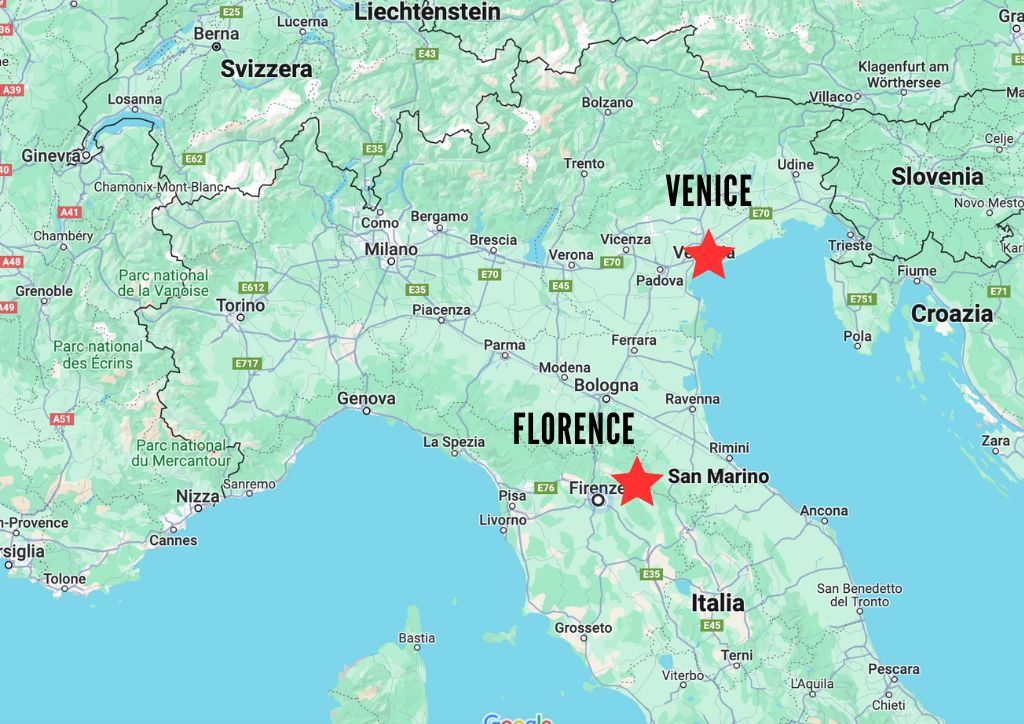
In order to cover that distance you have 4 options:
Is a day trip from Florence to Venice worth it?
This is a very frequent question, especially among travelers who have only a few days available to travel Italy. Unfortunately the answer is no, it’s not worth taking a day trip from Florence to Venice , and vice versa.
Both cities are too large, but above all too rich in things to do and see, to be visited in a single day . Also, since they are quite far away to each other , it takes at least 3 hours to go from one city to the other. With 6 hours needed just to get there and back, the time left available is really too little.
I recommend you to plan at least 2 days in each of these two Italian cities , but 3 days would be better.
If you still want to take a day trip to Venice from Florence or vice versa, take a look at these tours on Viator: in my opinion they are the best organised. They include transport, entrance tickets and guided tours. Tours last about 14 hours, which is a lot, but they are necessary to visit these places.
From Florence to Venice by train
This is definitely the best solution for a lot of good reasons . The train is the fastest option of all, and often the cheapest. In Italy there are high-speed trains that connect the two cities in 3 hours , they are very frequent and generally on time (but small delays are common).
There are two high-speed train companies in Italy:
- Trenitalia . High speed trains are called Frecce, but it also has slow regional trains. So when you do a search select “Frecce” from the drop down menu.
- Italo . This company only has high speed train.
Going from Venice to Florence with regional trains is doable, but honestly I don’t recommend it at all. It is true that they are cheaper than bullet trains, but the price difference is not so high as to justify such an uncomfortable journey. It takes at least 4 hours and you have to change trains twice, in Prato and in Bologna.
I also advise against Intercity trains, because they are more expensive than regional ones but just as slow. Furthermore, since they travel across the country from north to south making many intermediate stops, they always end up accumulating a lot of delays.
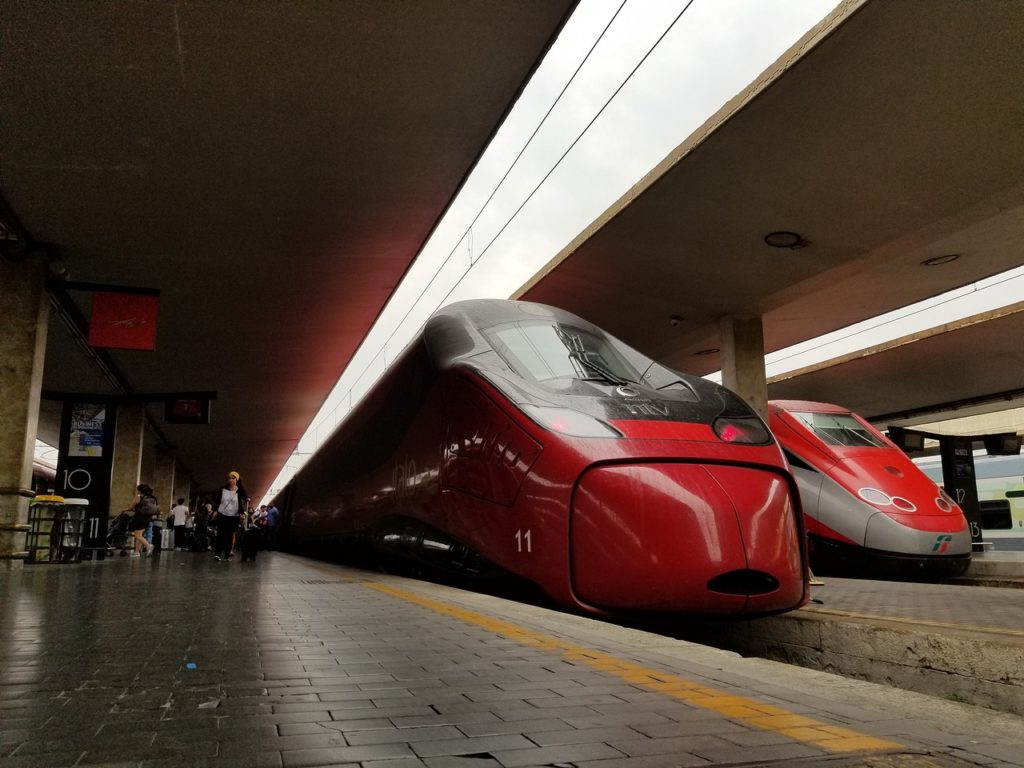
Some smart tips for booking trains in Italy:
Buy train tickets as soon as possible to find the cheapest fare.
Book from the official websites I linked before, if you don’t want to pay extra commissions to re-seller websites.
Remember that when you search on the Trenitalia or Italo websites, the names of the cities are indicated in Italian, so search for Firenze and Venezia, and not for Florence and Venice.
The main station in Florence is called Santa Maria Novella , while the most central station in Venice is called Santa Lucia. Both cities also have secondary stations, so be careful when selecting stations in the train company search engine.
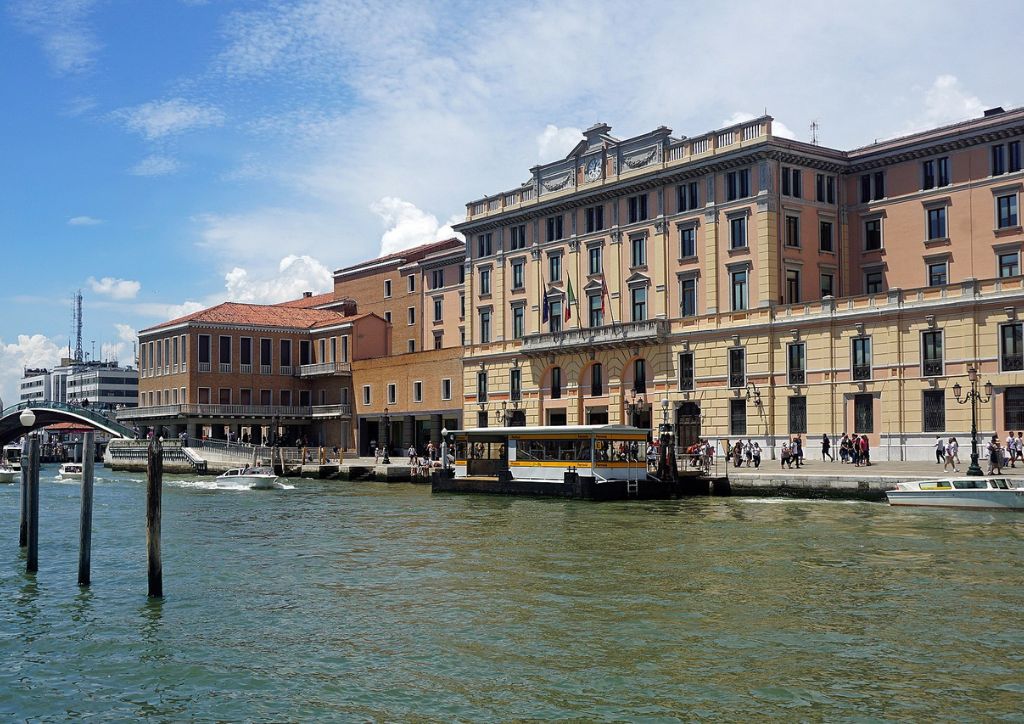
There are direct flights connecting Florence and Venice, but I don’t recommend using planes for a few reasons:
The flight is very short, less than an hour. But considering the time it takes to check in your luggage and go through airport security, it takes much longer than by train or car.
There are no low cost flights between these two cities, so the plane is always much more expensive than the train.
Florence airport is small and has a short landing strip: in case of bad weather or strong winds, flights are cancelled, delayed or diverted to Pisa or Bologna, the two closest airports.
Bus between Florence and Venice
You can get from Venice to Florence by bus, but once again I advise against it. Prices are very cheap, especially if you book in advance, but that’s the only pro. Cons are that there are only two companies, Itabus and Flixbus, and neither of them is reliable. Buses are often late due to traffic, and sometimes are even canceled at the last minute. The bus journey takes at least 4 hours.
Also consider that the bus stations are always far from the center, and since wheeled vehicles cannot circulate in Venice, the bus stops in Mestre, and from here you will still have to take the train to Santa Lucia station.
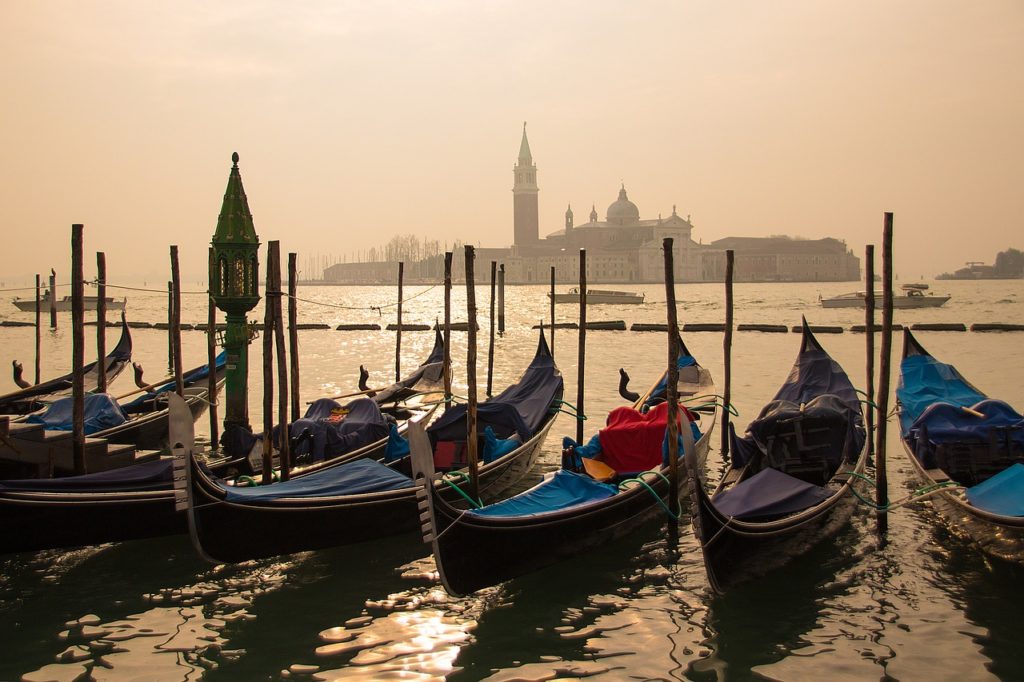
Getting from Florence to Venice by car
If you have planned a road trip in Italy with a rental car, to reach Venice from Florence you will have to take the A1 toll highway (Autostrada) to Bologna and then the A13 to Mestre. The route takes about 3 hours, if there is no traffic. But there is often traffic, especially around Bologna. Along the Autostrada you will find the famous Autogrill, the Italian service areas with bar, restaurant, snacks and souvenirs (we all love Autogrill for their giant candy packs).
I recommend using RentalCars to find the best deal among the most reliable international car rental companies.
- Read my tips for car rental in Florence
Again, I remind you that there cars are not allowed in Venice! So with your rental car you can get as far as Mestre at most. From there you can reach Venice by train in about 10 minutes.
If you are staying in a hotel in Venice you will have to find a park in Mestre where you can leave your car. Or you can decide to stay in Mestre (which is much cheaper) and reach Venice by train for the day.
- Smart tip: if Venice is the last stop on your trip, you can return the rental car to Mestre and never have to worry about it again. Ditto if it is your first stop, in this case you will only rent it when you will leave Venice for the next stop.
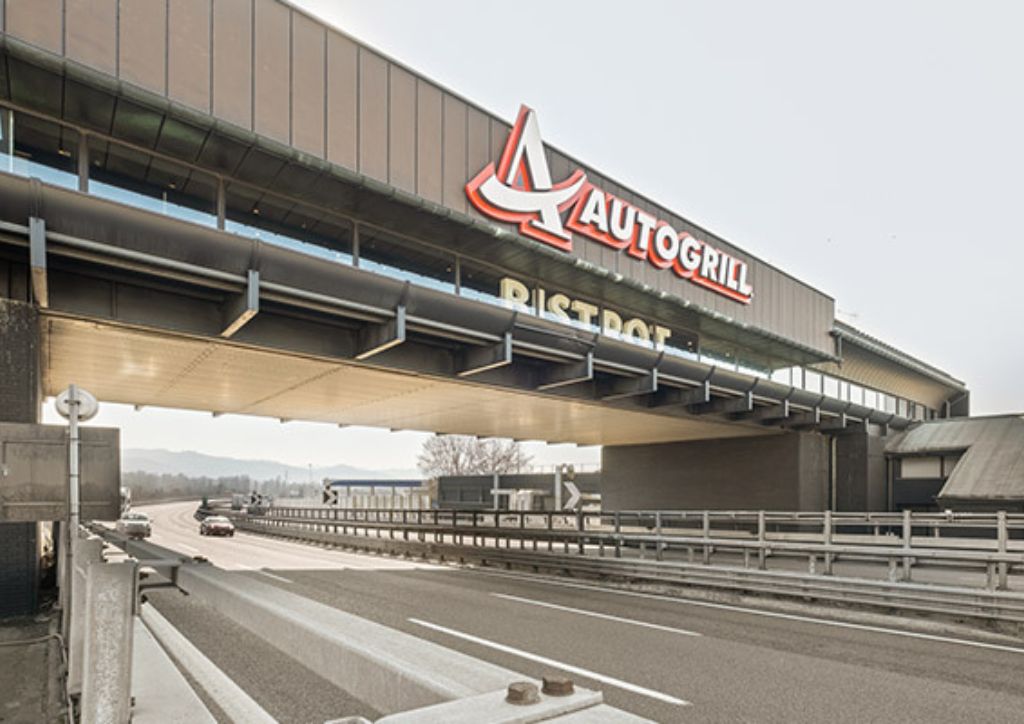
Intermediate stops between Florence and Venice
Whether you travel by train or car, along the route you can decide to make an intermediate stop and visit one of the many beautiful cities of northern Italy, such as Bologna, Ferrara or Padua.
These three towns are located along the road (and along the rail line), r equire no detours, and are small enough to visit in a few hours. Although all three are so rich in art, history and great food, that if you decide to stop by for a few days, you definitely won’t be disappointed.
Modena and Parma are also beautiful cities , with historic centers rich in art and architecture. But they are above all famous among foodies for their typical products: Parmigiano Reggiano, balsamic vinegar, prosciutto and much more.
Modena and Parma are not exactly on the route between Florence and Venice, but they are quite close to Bologna, so they only require a small detour.
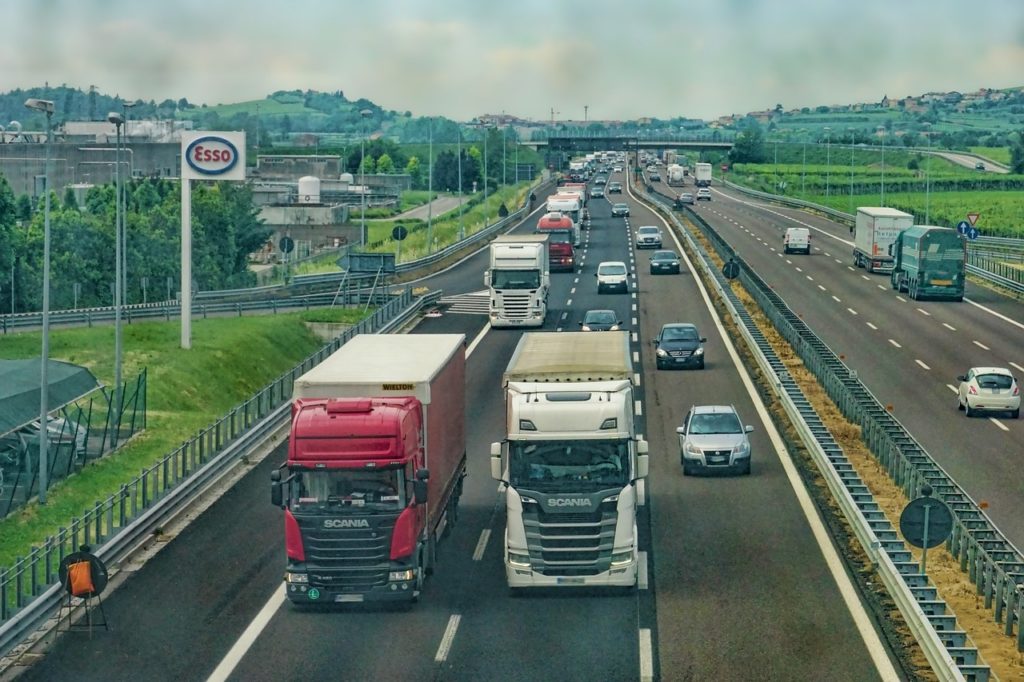
With a private transfer
If you have a lot of luggage, or if you just want to travel without fuss, you can book a car transfer with a private driver. Your driver will pick you up in front of your hotel or airbnb in Florence, and take you to Venice, taking care of everything, from your luggage to the itinerary. It is also an excellent solution for large families, just book a minivan.
- Private transfer from Venice to Florence (and vice versa)
- Private transfer from Florence to Venice with 2 hours for sightseeing (you can choose 2 stops of 1 hour each, between Ferrara, Bologna and Pomposa Abbey).
- What to do in Florence and Tuscany
@Claudiagarage, so far this is the best guide i have ever read about Venice and Florence, worth reading every word. Thank you for doing the heavy lifting, much appreciate the tons of information provided here.
Regards from Germany !!
Servus !! Ronald Silva
Grazie Ronald Silva for your kind words!!! I am happy that my blogpost are useful for travellers!
Leave a Reply Cancel reply
Your email address will not be published. Required fields are marked *
Save my name, email, and website in this browser for the next time I comment.
substack subscription
Demo Description
Subscribe the newsletter!
Tips for traveling Italy, news and updates from Florence, next events in town and more!
This will close in 70 seconds
Venice to Florence by Train: Plan your Trip
With more than 35 direct train services per day, it couldn’t be easier to travel between Italy’s blockbuster destinations, Venice and Florence. The 257-km rail route is now served by two high-speed rail operators, Italo and Trenitalia, reaching speeds of up to 360-km per hour. In theory, that means you could be enjoying an aperitivo in St Mark’s Square at dusk, then tucking into dinner in front of the Uffizi a little more than two hours later. If you’re planning on making the trip, we’ve analysed the best train options below.
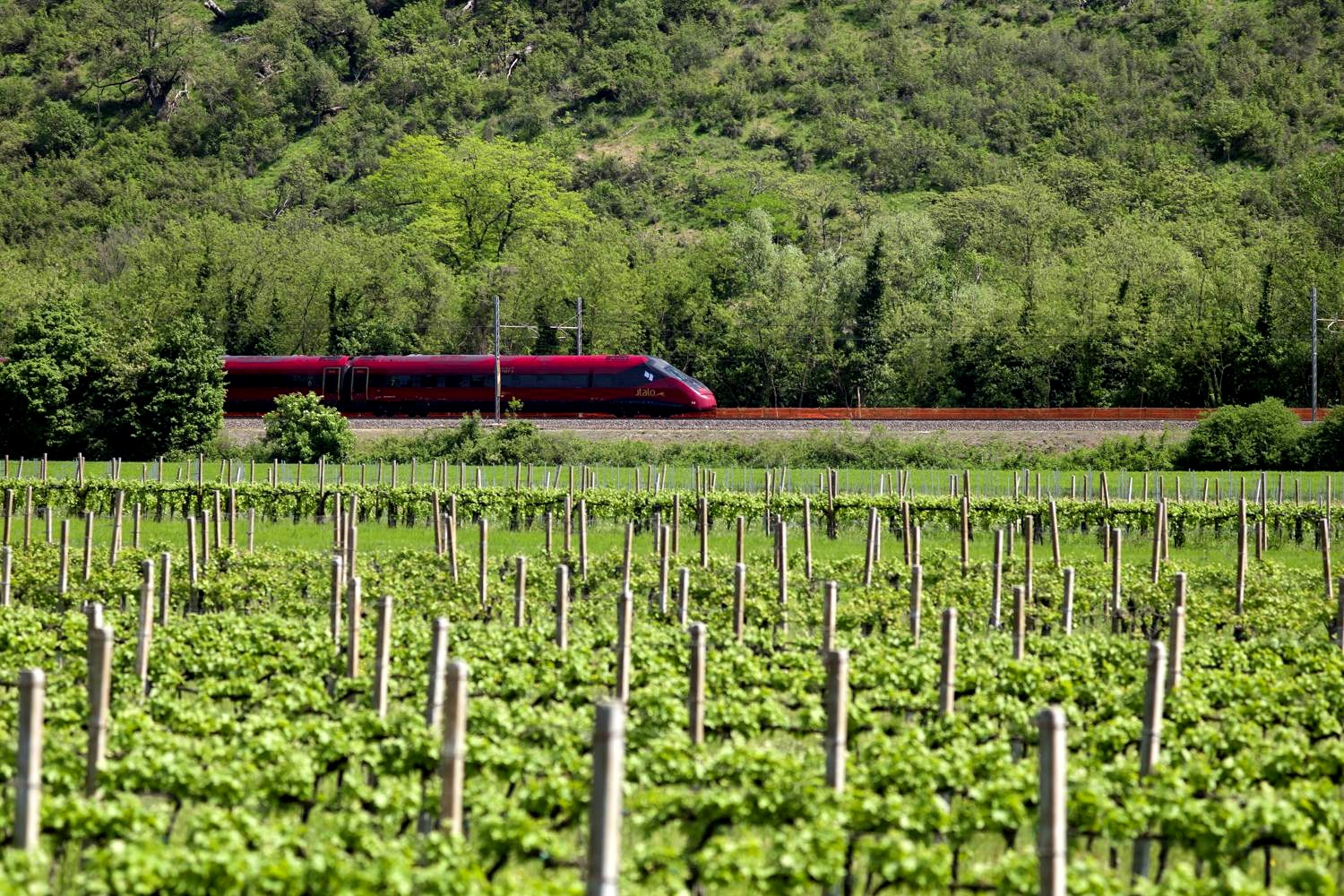
An Italo train races through the Veneto, between Venice and Florence (Photo: Italo)
All high-speed direct trains depart from Venezia Santa Lucia Station, the city’s main station, and terminate at Firenze Santa Maria Novella station. While there are some scenic stretches en-route, particularly along the Veneto, most of the journey is under cover. So, if you’re looking for sparkling vistas, you may want to opt for one of Trenitalia’s slower regional trains, which usually require a change at Ravenna and Ferrara. If you’re looking for a high-speed, direct route there are two options: privately-owned Italo and state-owned Trenitalia.
Italo trains, which launched in 2012, was created by two of Italy’s most powerful businessmen – Luca Cordero di Montezemolo, CEO of Ferrari, and Diego Dalle Valle, CEO of Tod’s. While they may not have designed the interiors themselves, they certainly influenced them. Spacious reclining seats covered in frau leather are standard across all classes. Carriages are air-conditioned, with free WiFi and power sockets at every seat. And, there’s also a smart cinema carriage showing selected films on TV screens suspended from the ceiling.
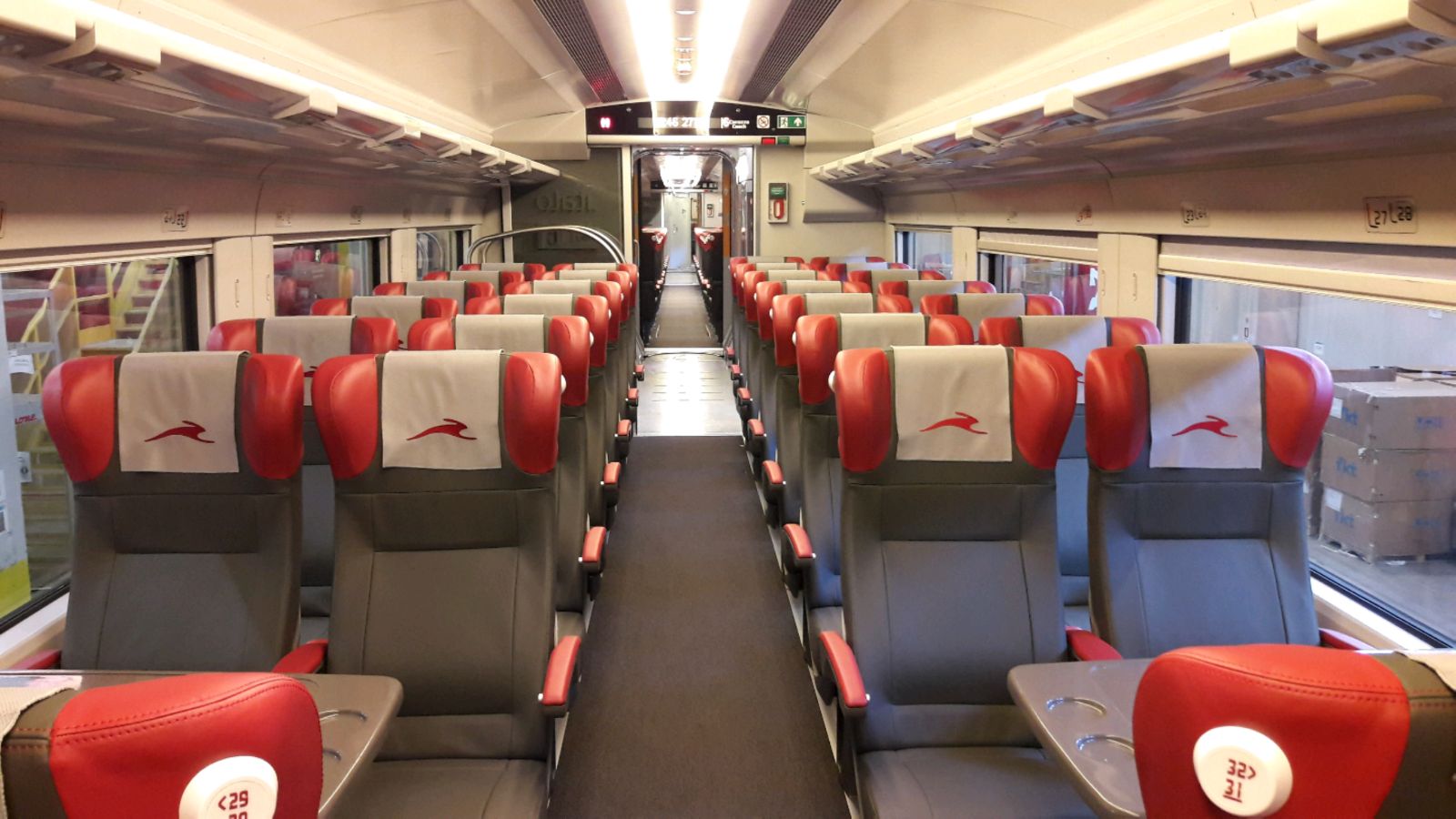
Inside 2nd class on an Italo EVO train (Photo: Italo)
Passengers can choose from four classes: Smart, Comfort, Prima and Executive. By usual 2nd class standards, Smart class is extremely comfortable, with ample legroom and comfy leather seats. Comfort class offers even more legroom, with three seats per row, instead of four. Prima class passengers can enjoy complimentary wine and snacks throughout the journey, and an innovative meal-in-a-box from EatItaly, served at your seat. Club Executive caters for business travellers, offering just 11 seats in a saloon-style carriage, each featuring a 9” LCD-touch screen television. Business travellers can also reserve one of two intimate salottinos or private berths for meetings too.
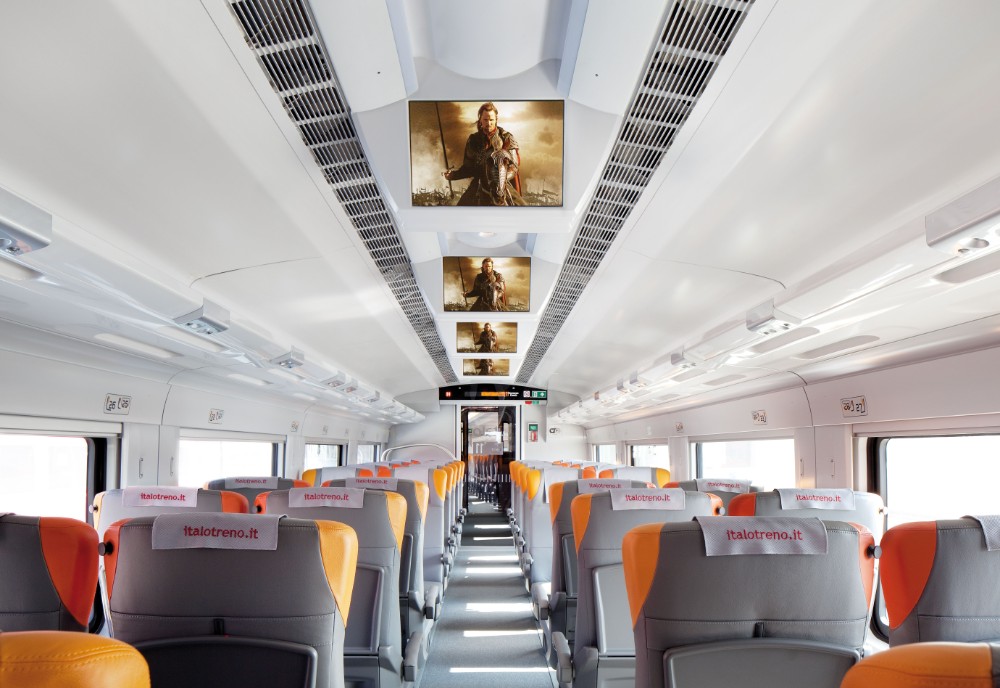
The cinema carriage on an Italo train from Venice to Florence (Photo: Italo)
Visitors who chose to travel with Trenitalia will travel by Frecciarossa or Frecciargento service. Both high-speed trains are air-conditioned, offering free WiFi and power sockets at every seat. Luggage can be stored overhead or in large luggage racks at either entrance. Many services are operated by the Frecciarossa 1000, Trenitalia’s newest addition to the fleet, famous for its iconic long red nose. It’s also the first high-speed train in the world to have obtained EPD certification for environmental impact.
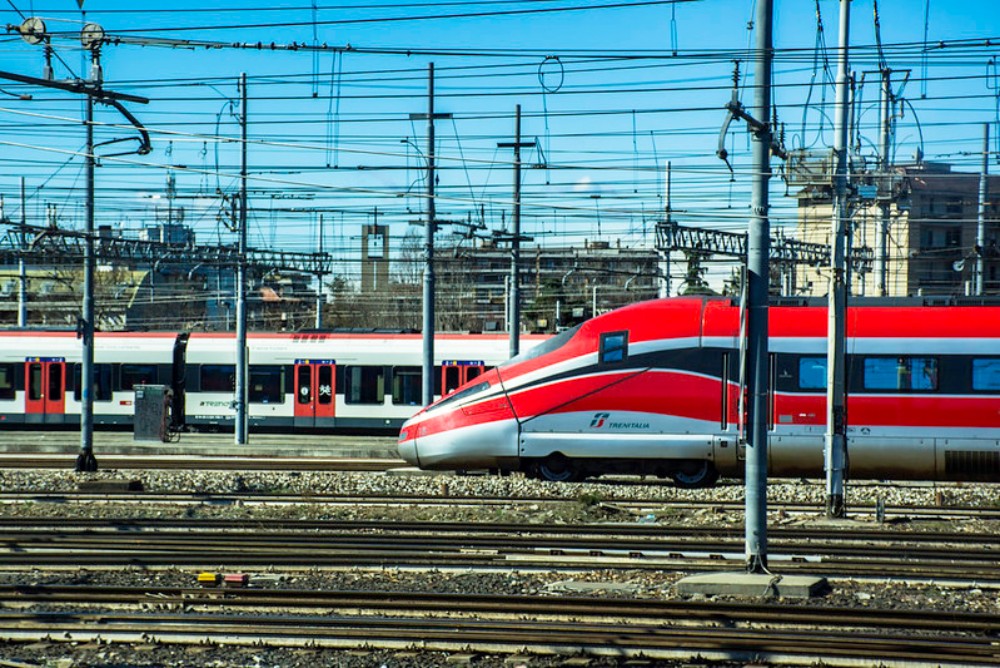
A Frecciarossa train with its iconic ‘long nose’ (Photo: David Almeida via Flickr/CC BY-NC-ND 2.0)
Like Italo’s offering, Frecciarossa trains now offer four classes. Standard features fabric seats, while Premium offers an identical seat layout with leather seats and a complimentary welcome drink too. In Business class, passengers are treated to more legroom, larger leather seats and a complimentary hot drink or alcoholic beverage. Or, for a premium experience, try the Executive class, which offers just eight extra-comfortable leather reclining seats with a dedicated steward. The price includes a complimentary cold tray and drinks, as well as an option to book the six-person meeting room. If you’re travelling by Frecciargento, there are only two classes available: 1st and 2nd class. 1st class will get you extra legroom, as well as a complimentary welcome drink.
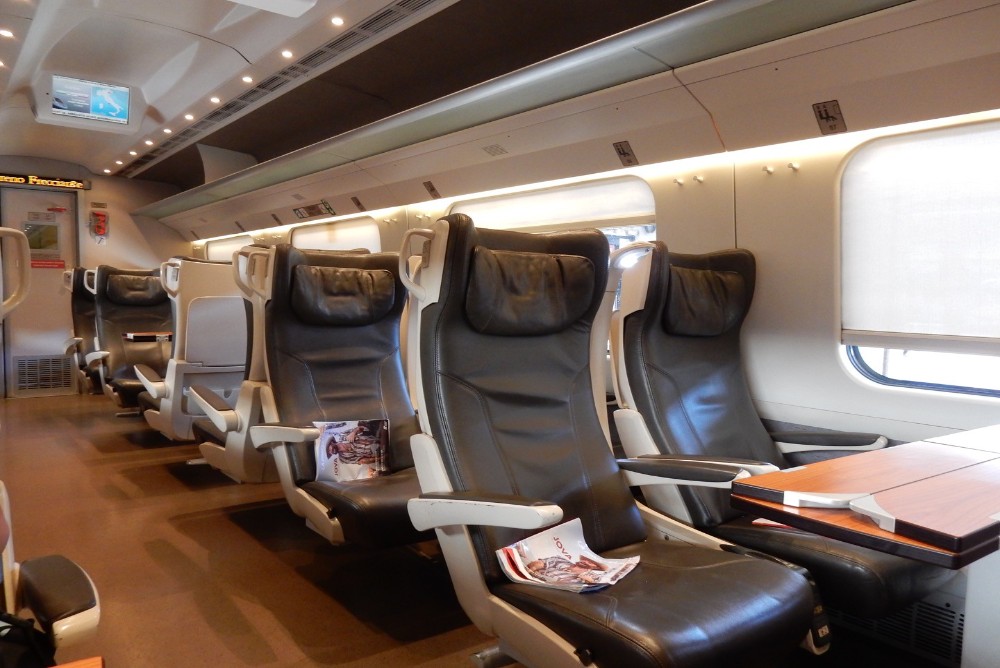
The interior of a 2nd class carriage on a Frecciargento train (Photo: Kanesue via Flickr/ CC BY 2.0)
Train schedule
The route between Venice and Florence is extremely well served, with an average of 35 direct services per day. Generally, Trenitalia operates a more frequent service, with at least one train every hour.
Rates and how to book
You can book trains up to six months before your departure date. Tickets from Venice to Florence start at €19.90 for Standard class tickets or €29.90 for Premium. Children under 4 travel free on Trenitalia’s Frecciarossa, while children under 3 go free on Italo.
We recommend booking tickets through Omio, a leading European train ticket comparison website guaranteed to find the cheapest available rate. The booking process is easy and takes just a couple of minutes, and you don’t even have to create an account either. Book your tickets at Omio.com .
Where to stay in Florence on a budget
Florence is a compact city, best explored on foot. The Santa Maria Novella station is located in one of four historic neighbourhoods, home to some of the city’s most important museums, palaces and churches, as well as the best shopping in the city along the Via de Tornabuoni and Via Della Vigna Nuova. Here we’ve rounded up three of the best accommodation offerings that combine style and service at an affordable price, all within walking distance to the station and Florence’s best sights.
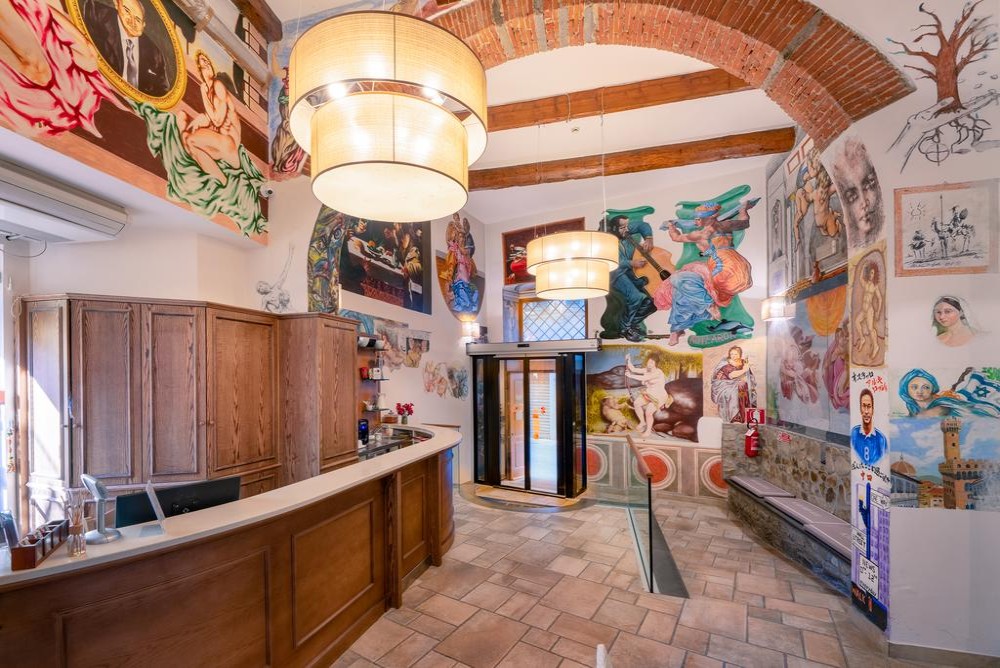
Walls are covered in hand-painted frescoes by local artists at Hostel Archi Rossi (Photo: Hostel Archi Rossi)
Run by two charismatic brothers – Leonardo and Marco – Hostel Archi Rossi is a friendly and laid back hostel conveniently located just 250 yards from Santa Maria Novella train station. Artworks from guests and locals adorn the walls of the lobby, leading out to a charming private garden and terrace. After a day of pummeling the pavements, guests can make use of the in-house wellness centre, which includes a sauna, hot tub and bookable massages.

The Suite at Casa Howard (Photo: Casa Howard)
For a budget bolthole that isn’t a hostel Casa Howard is a real steal. A stone’s throw from the station, it’s also just ten minutes walk from Florence’s most famous sites. Each bedroom is uniquely furnished, all Japanese-inspired pillar box reds and sumptuous emerald greens. There is no reception, but there are common areas throughout, all brimming with chinoiserie linens, antique furnishings and travel memorabilia, making it feel more like an ancestral home than a hotel.
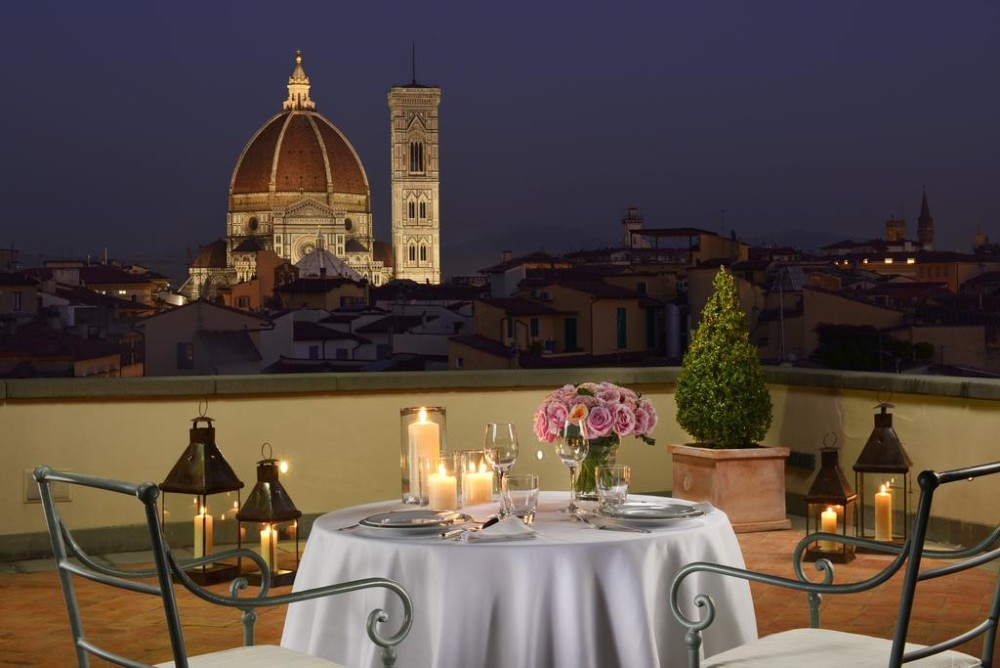
Views of the Duomo from the terrace at Hotel Santa Maria Novella (Photo: Hotel Santa Maria Novella)
For a mid-range option, try the Hotel Santa Maria Novella . With a sauna, fitness room and cocktail bar, it feels even more luxury than its four stars will have you believe. Each of the 71 bedrooms is decorated distinctively, with vibrant velvets, original parquet flooring and Carrara marble bathrooms. An intimate rooftop terrace is the perfect spot to wind down with a glass of chianti or negroni, overlooking the Duomo and the meandering Arno River as the sun goes down.
Latest Articles
- 5 of the Best Small Group or Private Tours of Germany May 9, 2024
- A Comparison of Hot Air Balloon Rides in Albuquerque May 9, 2024
- Cheap Short/ Long Term Parking at DFW Airport: Top 3 Spots May 9, 2024
- 5 Charming Hostels in Paris with Private Rooms May 7, 2024
- 48 Hours in Akureyri May 7, 2024
- BOOK TICKETS
- BUY RAIL PASSES
- TRAIN TRAVEL GUIDE
- ITALY TRAVEL TIPS
- RAIL PACKAGES
Florence Venice
A child is between the ages of 4 and 11 years.
Many trains in Italy and beyond offer a discounted fare between 30% & 50% off the Adult fare for Children.
The child offer is now extended to children ages 4 to 14 years when traveling on high-speed Frecciarossa, Frecciabianca, Frecciargento, InterCity, InterCityNotte, EuroCity, and Thello trains. Your child will be assigned his/her own seat and children must be accompanied by an Adult when traveling on this offer.
Regional trains will still offer discounted fares for children ages 4 to 11 years.
Infants & Children 3 & under travel for free and will share a seat with the adult companion.
This option is for customers that have already purchased a Eurail Pass or InterRail Pass and wish to reserve seats or sleeping berths. Learn more about rail passes.
Most high-speed and long-distance trains require seat reservations. The fare rules for each train indicate whether seat reservations are necessary.
Note: An ItaliaPass does not entitle customers to use of passholder fares. Roundtrip tickets are not available using a Eurail Pass or InterRail Pass.
By clicking the "I ACCEPT" button below you acknowledge that passholder fares may only be used in combination with a valid Eurail Pass or Interrail Pass.
Save as much as 10-30% OFF rail Enjoy flexible ticket changes Amazing deals on tours, transfers, and more Dedicated travel coordinator (for the best service, book at least 2 weeks in advance)
Get Started Now >>
There’s no better way to make the journey between Italy’s two most beautiful cities. The distance from Florence to Venice is 160 miles; some high-speed trains make this journey in just 2 hours and 5 minutes, while slower, regional trains can take up to 6 hours.
The Florence to Venice train travels north from the heart of Tuscany , through Italy’s scenic Tuscany and Emilia-Romagnia regions to the Adriatic coast. Many trains stop in Bologna en route to Venice. On the faster routes, you won’t be required to change trains. However, if you’re traveling on a slower and less expensive regional train, you may be required to transfer from one train to another.
Florence to Venice train times
Trains leave Florence Santa Maria Novella station a few times per hour for Venice's Santa Lucia station — averaging 52 trains per day. The earliest train leaves Florence Santa Maria Novella for Venice at 5:35 a.m. The last train to Venice leaves Florence at 9:30 p.m.
Note that weekends and holidays typically mean less frequent service and sometimes longer travel times.
Amenities on the train between Florence and Venice
Many high-speed trains make the daily journey between Venice and Florence in just 2 hours and 5 minutes, traveling as fast as 155 miles per hour.
Italy’s high-speed trains are equipped with air conditioning and electrical outlets at your seat to charge devices. There is wi-fi on trains , but the signal will drop in tunnels and at stations. Expect a cafe car on every train , as well as food cart that brings snacks, sandwiches and beverages to your seat. At the end of each car you’ll find a restroom and plenty of racks to store large luggage .
Firenze SMN train station is a hub for Italian and international high-speed and regional trains. Located in Florence’s central Piazza della Stazione, SMN station puts you conveniently close to Florence’s big attractions. Outside the station you’ll find taxis, a tourist information office, and stops for most of the city’s main bus routes.

Santa Lucia station, also known as Venezia S. Lucia, is the city’s central train station. Located across the Grand Canal from the historic Santa Croce district, Santa Lucia station provides high-speed train service to international and Italian destinations, as well as slower regional service to towns and cities throughout northeast Italy.


Florence to Venice – A Fascinating Day Trip in Italy (With Travel Tips and Sights to See)
By Author Rossi Thomson
Posted on Last updated: 5th September 2022
Categories Day Trips in Italy , Tuscany , Veneto , Venice
A day trip from Florence to Venice in Italy is entirely possible and very enjoyable.
Plus, it gives you a chance to explore two of the most famous renaissance city-states in the span of the same italian holiday..
For its location in the heart of the Venetian Lagoon, Venice is universally known as the world’s most unique and beautiful city. Venice is also rich in important historic and artistic sights, it is a hub of artisan crafts and a stage for large-scale worldwide known events. In a nutshell, the city of water offers a great number of things to see, do, and enjoy. Several of them can be covered in a day.
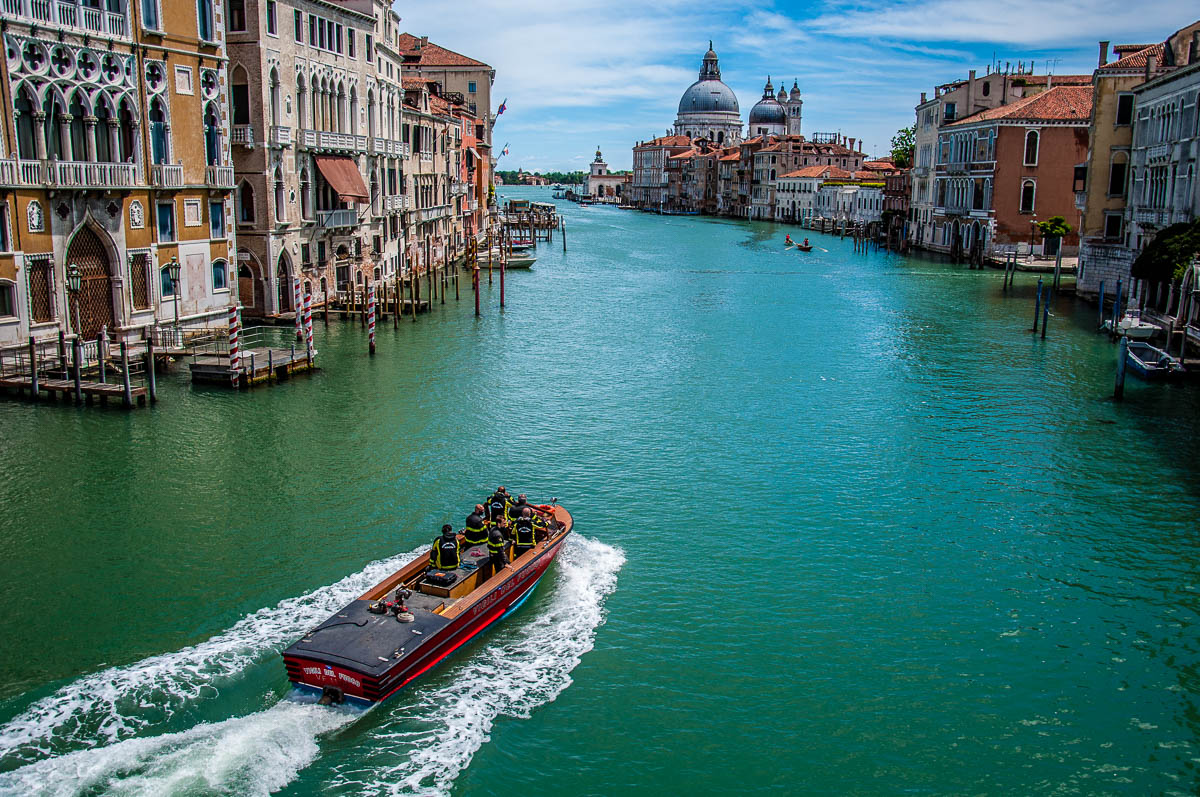
With a travel time starting from just over 2 hours one way and with high-speed trains and modern motorways connecting Florence and Venice , this is a day trip in Italy that requires a bit of organisation and sticking to strict departure times. Yet, with a bit of forward planning, it’s entirely possible, so don’t miss the chance to take it!
To make it easy for you, in this blog post, I have collated all the details to make planning a day trip from Florence to Venice a success. From first-hand tried and tested information on how to travel between these two Italian cities to a shortlist of the major sights to see in Venice in a day, everything’s covered.
Now, I would like to share my tips with you to help you have a great experience, too. Logically organised in easy chunks, below you will find the information that you need to enjoy Venice on a great day trip from Florence in Italy.
Have a look!
Florence to venice – a fascinating day trip in italy (with travel tips and sights to see), where is venice, italy.
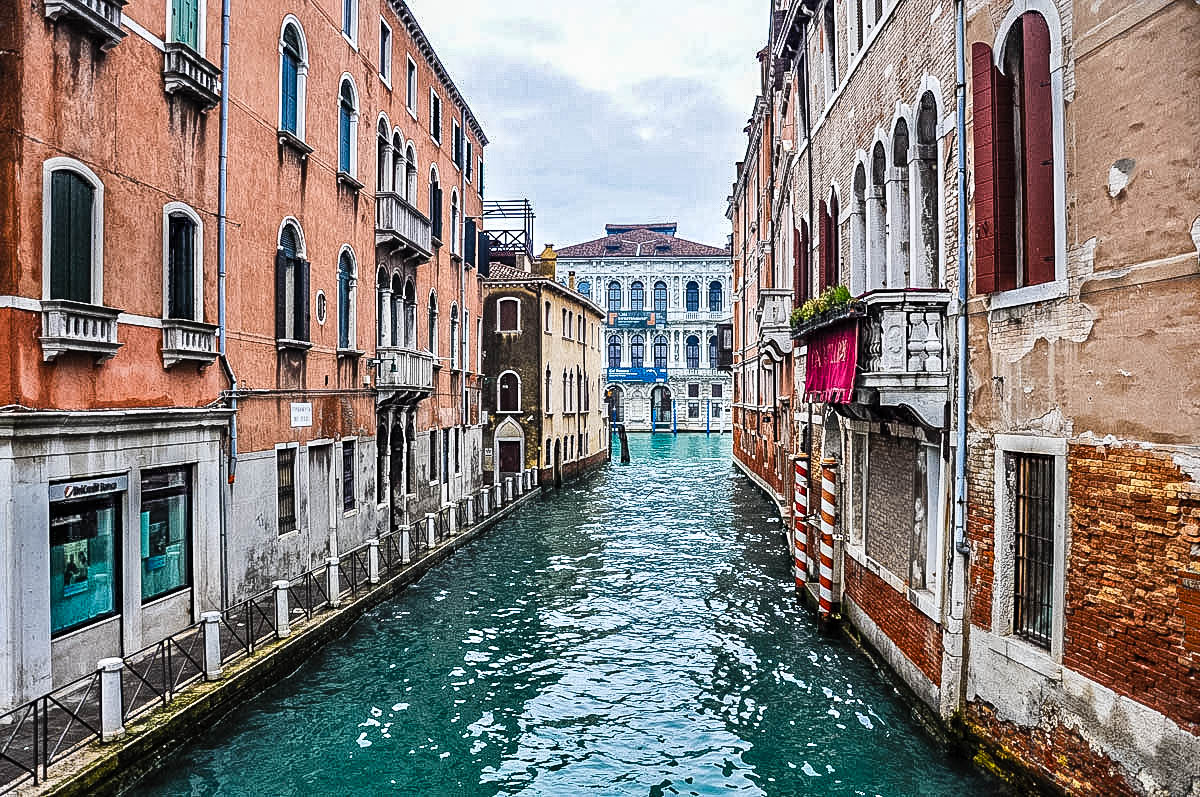
Venice is the capital of the Northern Italian region of the Veneto . Famously, the historic centre of the city is built on 118 small islands grouped together in the heart of the Venetian Lagoon. A long car and railway bridge connects Venice to the mainland.
Florence itself is the capital of the Central Italian region of Tuscany. The distance between Florence and Venice is around 260 km.
Venice is connected to Florence by road and railway. Travel between them is straightforward and with a bit of planning, it doesn’t have to cost the earth.
The train station of the historic centre of Venice is called Venezia Santa Lucia. It is an end of the line station and among the 14 largest and busiest train stations in Italy. On average, it serves 450 high-speed and regional trains a day and deals with 30 million passengers a year.
Besides Florence, Venice is easy to reach from a number of large Italian cities. For example, Bologna , Verona , Milan , Turin, and Naples in addition to the Italian capital Rome. Venice also enjoys excellent railway connections to several important European cities in Austria, Switzerland, Germany, and France.
Geographically speaking, Venice has two parts:
- The historic centre of Venice – built on 118 islands in the Venetian Lagoon and surrounded by water on all sides. This was the capital of the Republic of Venice and nowadays is one of the biggest tourist destinations in the world. If you want to explore the beauty and heritage of Venice on a day trip from Florence, you need to travel to the Venezia Santa Lucia train station which serves the historic centre of Venice.
- The mainland area of Venice – known as Venezia Mestre or simply Mestre, this is the large borough on the mainland. The trains from Florence to Venice first stop at the Venezia Mestre train station before heading across the water to the Venezia Santa Lucia train station in the historic centre of the city. First-time visitors at times get confused and get off the train at Venezia Mestre. Unless you have a specific interest in Mestre, you need to stay on the train until the end of the line at Venezia Santa Lucia.
Why Visit Venice from Florence?
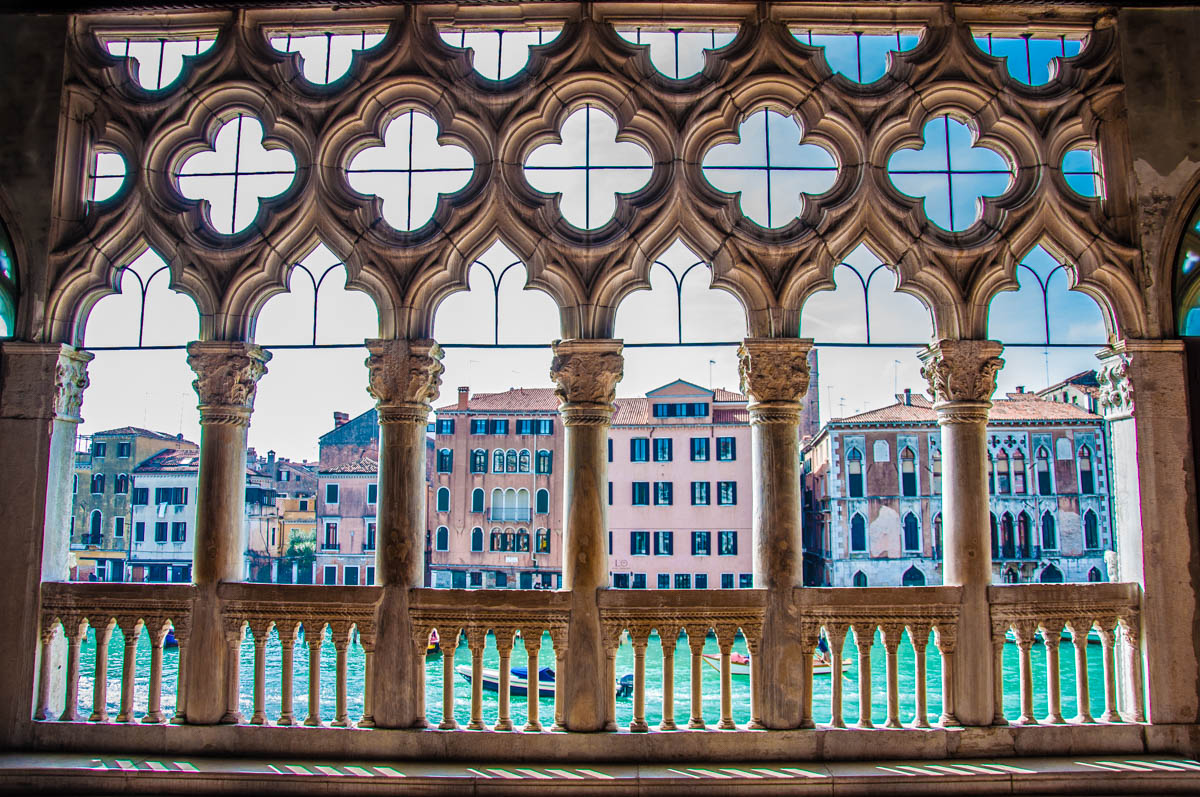
If you are spending a few days in Florence and have already visited the many beautiful historic towns and cities nearby (for example, Sienna, San Gimignano, Volterra, and Bologna ), you may want to also take a day trip to Venice.
Venice, after all, is always a good idea! The city of water doesn’t really need any introduction and it’s famous worldwide for its unique location, multilayered history, priceless works of art, and mesmerising beauty. Once the capital of the mighty Republic of Venice which ruled over the Mediterranean trade for more than 1,000 years, nowadays the historic city of Venice is a must-see for anyone who loves beauty, art, and history.
With a history that spans many centuries, Venice is an important cultural and artistic centre in Northern Italy . For its concentration of unique historic, urban, and artistic landmarks and for its extraordinary natural landscape, Venice and its Lagoon have been a UNESCO World Heritage Site since 1987.
From its main sights – many of which are clustered around the spectacular St. Mark’s Square and Grand Canal – to its hundreds of hidden gems and corners dotted all over the historic centre, Venice is always a delight to discover. With a bit of forward planning and having a clear idea in mind as to what you want to see there in a day, a trip from Florence to Venice can be a cool adventure to leave memories that last a lifetime.
How to Travel from Florence to Venice?
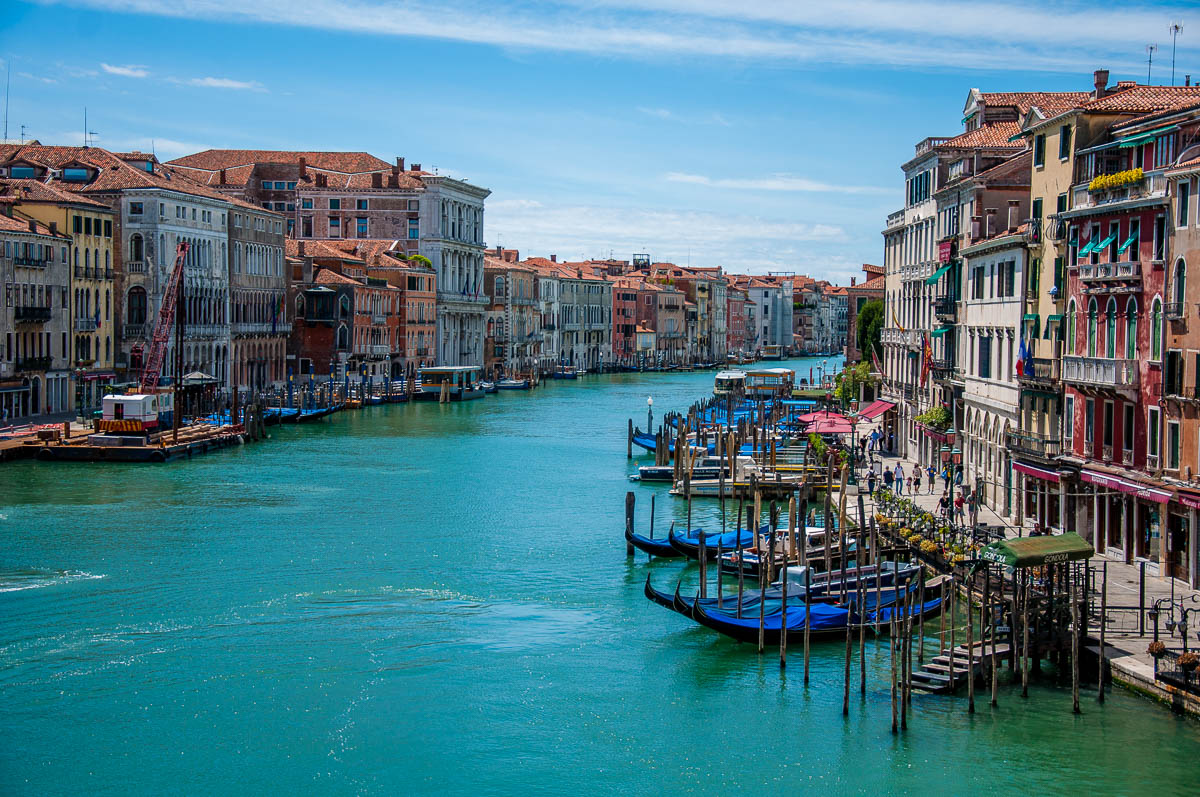
There are two main convenient ways to travel from Florence to Venice for a day trip. Here they are in further details:
Florence to Venice by Train – train times are very manageable if you take the direct high-speed trains. Taking the much cheaper regional trains will increase the journey by several hours and will make a day trip from Florence to Venice unfeasible. The regional trains can be a great and inexpensive travel option if you are planning to spend more than one day in Venice though.
Here is how it works:
High-speed trains ( Frecciarossa and ItaloTreno ):
- On average they take about 2 h 14 mins from Firenze Santa Maria Novella train station to Venezia Santa Lucia train station.
- They are very swish and travel really fast .
- However, this type of trains cost more and the tickets for them get more expensive the closer to the date of travel you buy them.
- The earlier you buy your tickets , the less you will pay. Plan ahead and keep an eye on the TrenItalia and ItaloTreno websites for the best pricing.
- If you only have a day to spend in Venice and you want to minimise your travel time, maximise your sightseeing time , and can buy your tickets well in advance, then definitely get the direct high-speed train from Florence to Venice.
High-speed trains + Fast regional trains ( Frecciarossa + Regionale Veloce ):
- Alternatively, you can take the Frecciarossa high-speed train from Firenze Santa Maria Novella train station to Bologna Centrale train station. Once there, you can take a Regionale Veloce train to Venezia Santa Lucia train station. This option is cheaper however the travel time will increase by just under an hour.
- As you will be using a high-speed train for a portion of your journey, again, it is advised to buy your tickets well in advance in order to take advantage of the cheaper advance prices.
- Bear in mind that tickets for the Regionale Veloce trains traditionally need to be validated before boarding the train. Basically, you need to place your ticket in the slot of one of the validating machines. You will find them affixed to the walls and pillars of the train station. The machine will make a whirring noise and print a code on your ticket. If you don’t do it, your ticket is not valid and fines are large.
Train Stations:
The main train station in Florence is called Firenze Santa Maria Novella . This is one of the busiest and most important railway stations in Italy. High-speed and regional trains connect it to many cities and towns all across the country. With locals travelling for work and millions of tourists visiting Florence each year, you will find Firenze Santa Maria Novella a hub buzzing with activity all throughout the day. To avoid stress, make sure that you allow plenty of time to buy tickets (if you haven’t bought them online or on-site in advance), to find the respective platform, and board the train.
Depending on where you are staying in Florence, there are two more stations that you may need to use:
- Firenze Campo di Marte – a train station in the south of Florence.
- Firenze Rifredi – a train station in the north of Florence.
You can use these train stations either to travel to Firenze Santa Maria Novella, to Bologna Centrale or to take a combination of Intercity, regional, and fast regional trains all the way to Venice (which can be an inexpensive way to travel if the length of travel time is not an issue).
As mentioned above, there are two train stations in Venice, too. Both of them are on the same train line:
- Venezia Santa Lucia train station – if you want to visit Venice proper, i.e. the historic centre of Venice on the islands in the Venetian Lagoon, this is the train station you need to travel to. The travel times given above apply to the journeys from Firenze Santa Maria Novella to this train station.
- Venezia Mestre train station – if you have a specific interest in Mestre – the mainland administrative borough of Venice, you need to travel to this station. It precedes the Venezia Santa Lucia train station and travel times from Firenze Santa Maria Novella to it will be on average 10-12 mins shorter.
Buying Tickets Online:
To check travel times from Florence to Venice by train and to buy train tickets in advance, you can use one of these two websites:
- TrenItalia – for Frecciarossa high-speed trains and regional trains;
- ItaloTreno – for ItaloTreno high-speed trains only.
Both are easy to navigate and have an English user interface. The only thing to remember is that on the TrenItalia website you need to use the Italian names of the train stations (as given above) when you are doing a search for tickets.
Florence to Venice by Car – if you prefer, you can travel from Florence to Venice by car. The journey by toll roads can take anything from 2 h 40 mins to almost four hours depending on the itinerary you follow and how heavy the traffic is. Using GPS navigation is indispensable as traffic jams occur and it can help you avoid them as much as possible. Be prepared for a more of an assertive type of driving and drivers that seem to be on the offensive.
In principle, travelling by toll road is the quickest way to get around in Italy. From Florence to Venice, there are four motorways to travel on one after the other: Autostrada del Sole – A1, Autostrada Adriatica – A13 (for a matter of minutes), Autostrada Bologna-Padova – A14, and Autostrada Serenissima – A4 (again for a matter of minutes).
This website lays out the whole itinerary in minute detail. And this website will give you an estimate of how much the tolls are going to cost.
As you know, Venice is a car-free city. You can park on the island of Tronchetto which is like one huge car park. Just follow the signs after crossing over from the mainland on the long Liberty Bridge. It’s easy and your GPS app will be able to point you in the right direction. Once at Tronchetto, you can get the people mover to Piazzale Roma and start exploring from there.
Another option is to park at one of the car parks at Piazzale Roma and either walk from there or take the vaporetto (Venice’s water bus) from there down the Grand Canal.
If you do a search online, you will find several different car park operators in Tronchetto and Piazzale Roma. Then you can choose the most convenient one for you.
What to see in Venice on a Day Trip from Florence?
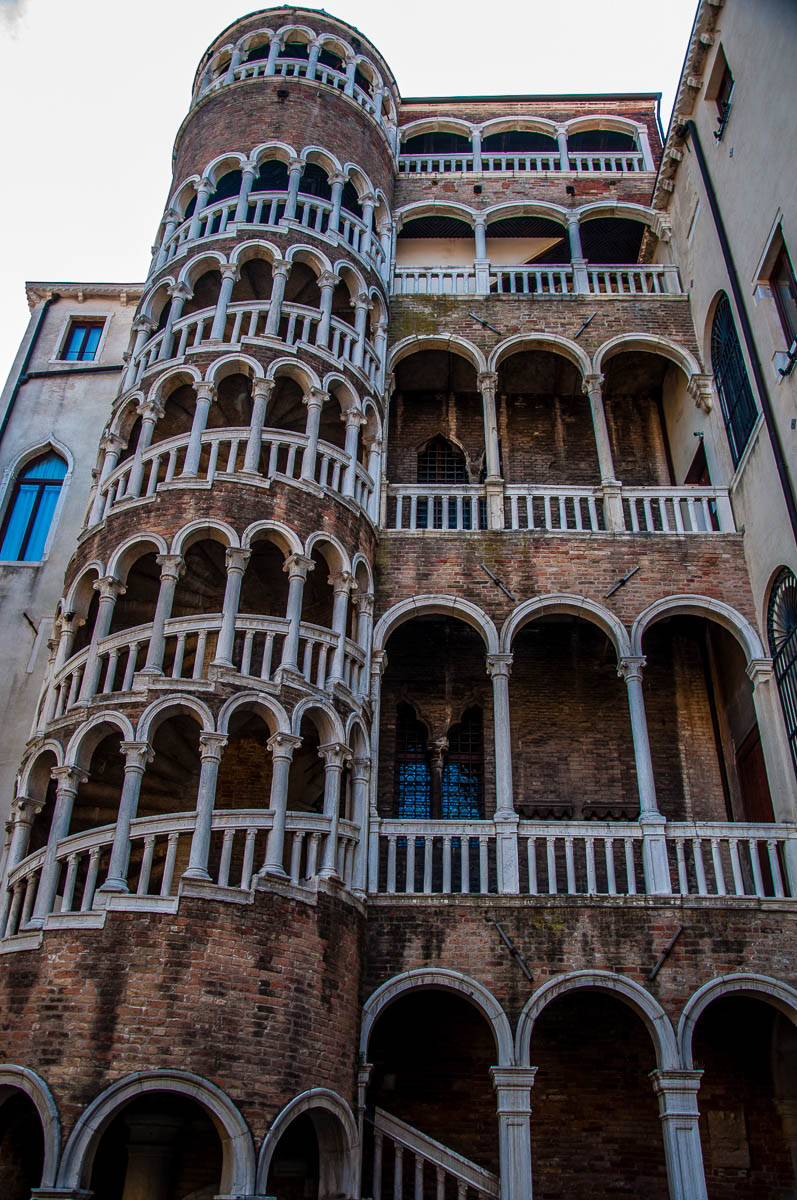
One day is never enough for Venice but it’s better than none. There are many things to do, see, and fall in love with in Venice, Italy. If you have a plan in mind and/or are prepared to be walking around all day in search of hidden gems, you can certainly cover a lot of ground here from morning till dusk.
Just make sure that you wear your most comfortable shoes and clothes. In summer, bring a water bottle with you (you can refill it from the free water fountains around town). Above all, don’t be afraid of getting lost once or twice (it’s part of the experience of being in Venice).
A great introduction to the beauty of Venice is to simply take vaporetto number 1 either from Piazzale Roma or from Venezia Santa Lucia train station down the Grand Canal. This way, you will be able to see numerous splendid palaces, historic churches and Rialto Bridge before arriving in style at St. Mark’s Square where many of the city’s major sights are grouped around.
Here is a shortlist to get you started planning your day trip from Florence to Venice:
- Grand Canal – take vaporetto number 1 all the way to St. Mark’s Square. The journey down the Grand Canal is a fabulous introduction to the beauty of Venice. Along the way you will see such stunning buildings and structures as Ca’ Pesaro , Ca’ d’Oro , Rialto Bridge, Ca’ Rezzonico , Accademia Bridge, Gallerie dell’Accademia , and Basilica Santa Maria della Salute . The vaporetto (this is what water buses are called in Venice) will take you all the way down to the large expanse of water known as St. Mark’s Basin with St. Mark’s Square and the Doge’s Palace on one side and the islet of San Giorgio Maggiore on the other.
- Doge’s Palace – a visit to this splendid pink and white Gothic building will give you an excellent idea about the Republic of Venice as a political and commercial titan during its heyday. You will also gain an understanding of the Republic’s unique governmental structure and will see some truly stunning monumental pieces of art.
- St. Mark’s Basilica and St. Mark’s Campanile – Venice’s most iconic church that is covered with gold mosaics inside. Its belltower is almost 100 m tall and it’s diagonally across from the basilica’s facade. Make sure that you take the lift to its top to enjoy breathtaking views over the city of water.
- Rialto Bridge and Rialto Markets – one of Venice’s most famous sights, the elegant stone arch of Rialto Bridge straddles the Grand Canal at its narrowest point. Right next to it you can explore the Rialto markets offering an abundance of fresh produce and fresh fish.
- Museums, churches, and sights – two of the most famous museums here are Gallerie dell’Accademia and Peggy Guggenheim’s Collection . In addition, there is a whole host of museums, churches, and sights here to satisfy every type of interest in history and art. Here are some suggestions: Fondazione Querini Stampalia , Ca’ Pesaro , Ca’ Rezzonico , Teatro La Fenice , Scuola Grande San Rocco , Basilica dei Frari , and Scala Contarini del Bovolo (pictured above).
- Cicchetti – take every opportunity to enjoy Venice’s own finger foods that are traditionally washed down with a glass of wine (called ombra by the Venetians);
- Historical Events – if you are in Venice at the right time, enjoy a splendid event. Carnevale , Venice Historical Regatta , the Regatta of the Ancient Maritime Republics , and the annual Befana race are particularly famous.
- Private Tours with a Truly Venetian Local Guide – for private tours of Venice, I always recommend Luisella Romeo from See Venice and Erika Cornali from When in Venice . They can help you experience Venice authentically and tailor a tour to your specifications.
There are many more beautiful sights and unique locations to visit in Venice, Italy on a day trip from Florence. If you are after some hidden corners and little-known gems, make sure that you read this exhaustive article:
- Hidden Gems in Venice – 101 Things to Do in Venice, Italy Off the Beaten Track
It covers in extensive detail the many curious, weird, and whimsical things that make Venice such a unique city and a must-see destination when you are in Italy.
What Is Your Personal Experience of Travelling to Florence and Venice in Italy?
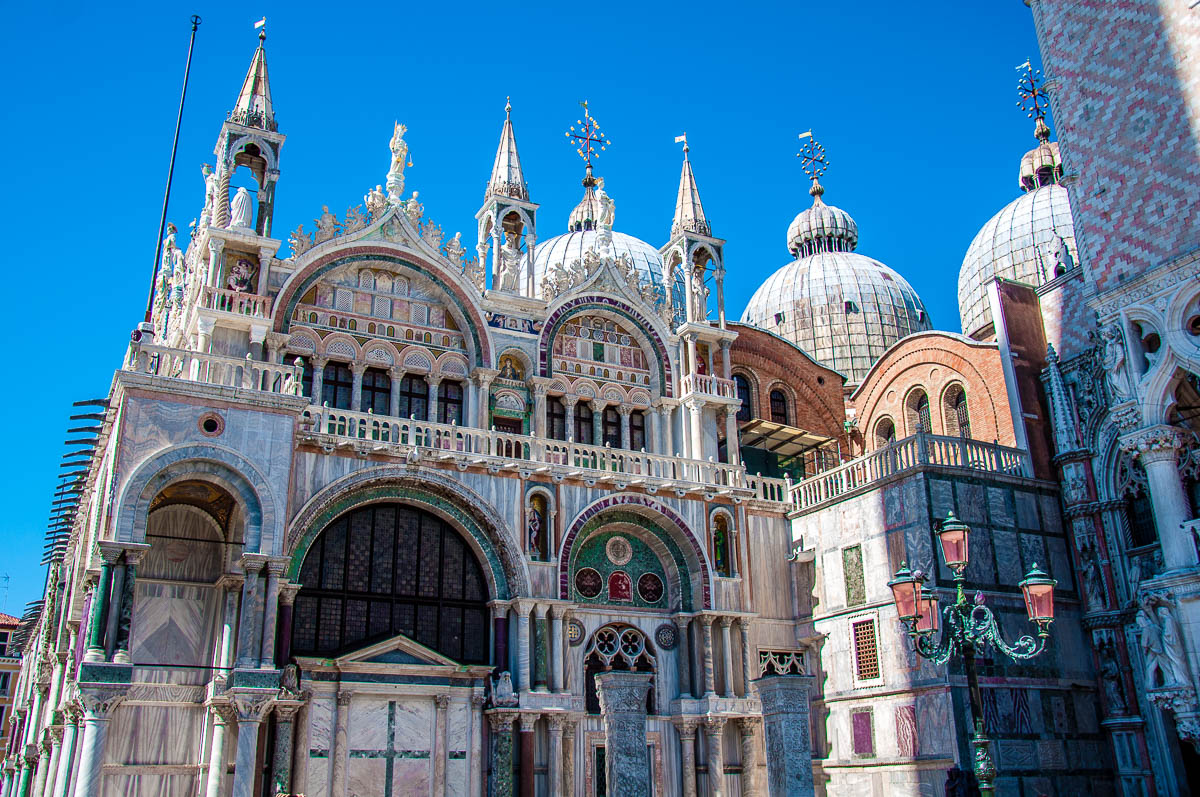
I spent six years living in Vicenza – an elegant historic city about 45 mins up the road from Venice in Italy. As such, I took every opportunity to travel to both Venice and Florence to explore their art, history, culture, unique events, delicious food, and lovely city settings. In addition, before moving to Italy, I had travelled numerous times from England to both cities for city breaks and long weekends.
Travelling by train and by car around the Veneto and Tuscany is easy and toll roads are not that expensive. The motorways are modern and in general very well maintained. Many trains connect Florence and Venice all throughout the day.
The high-speed trains, in general, are very clean, new, and well-maintained. They feel very swish. While they can get quite busy in the mornings and in the late afternoons with business people commuting between Venice, Florence, and the towns and cities between the two, the journey is very comfortable.
If you prefer to travel by fast regional train from Venice to Bologna and then take the high-speed train from Bologna to Florence, this is manageable, too. I did it once and although I am always for the shortest travel times possible, the price was more palatable and made me overlook the extra hour of travel.
Venice has so much to offer that a day here quickly flies away. Delving into the city’s history and art is very satisfying for you always end up discovering new things. Even if you are here just for a day, you can explore places of great historic, architectural, and artistic importance. Plus, the city as a whole is very beautiful and turning every corner, crossing every bridge, walking along every canal reveals more beauty to truly fall in love with.
Yes, crowds besiege the most popular sights. In summer the sun can be very, very hot. Yet, Venice – the real, authentic one – is easy to discover even on a day trip. The city of water has a way to get under your skin, to make you really fall for it.
I full-heartedly recommend taking a day trip from Florence to Venice to anyone spending a few days in Florence and wanting to see Italy’s other worldwide famous Renaissance city with their own eyes.
A small disclaimer is due here: All the information contained in this blog post is up to date at the date of publishing it. This is not professional, exclusive advice. Just personal experiences and suggestions shared without any obligation to you and any expectations from you.
In Conclusion
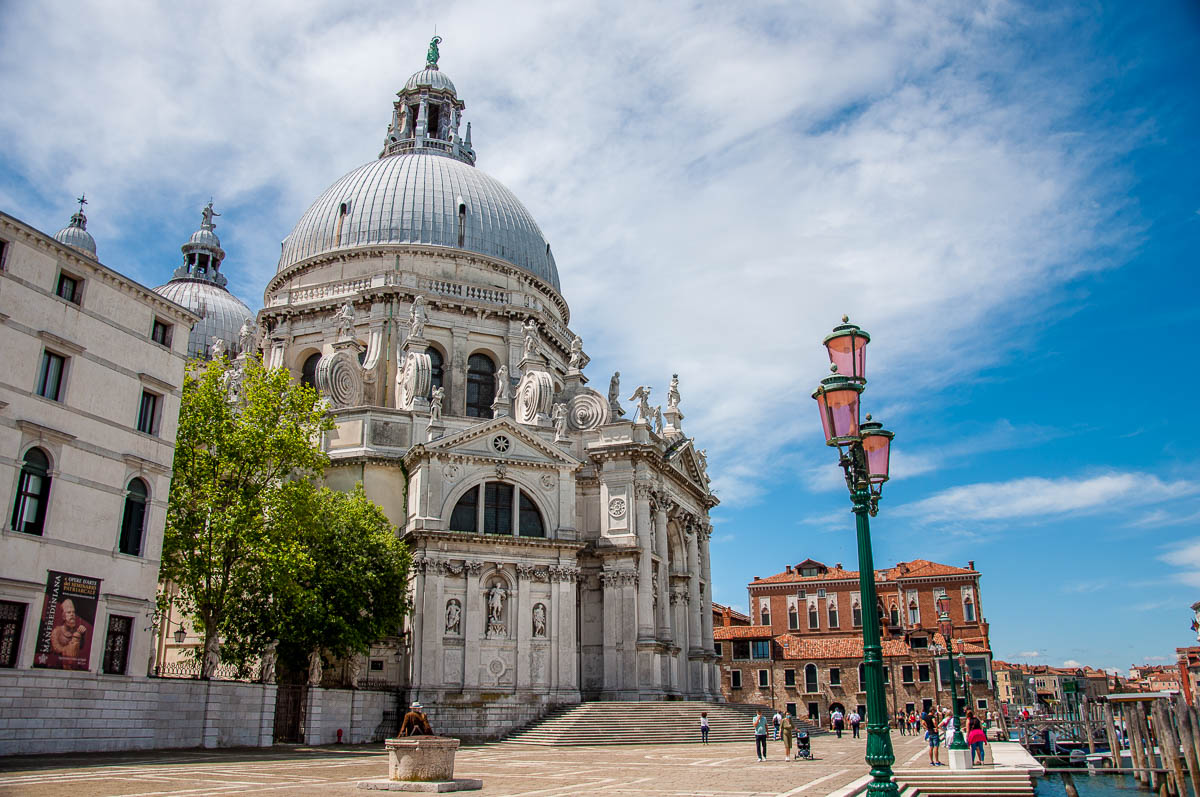
Taking a day trip from Florence to Venice is a great way to make your Italian holiday even more exciting.
These are two of the most famous cities in Italy and the world. While Florence and Venice are not close geographically, thanks to high-speed trains and modern motorways, they are a manageable distance away from one another.
Hence visiting Venice from Florence can be very straightforward. Venice – universally recognised as the world’s most beautiful city – has many splendid sights and museums. Several of them can be covered in one (hectic!) day.
In the above blog post, I give you detailed information on how to make such a day trip. From how to get from Florence to Venice as swiftly as possible to a shortlist of what to do and see in Venice in one day, all the bases are covered.
I hope that the information provided will galvanise you to put Venice at the top of your travel wish list and that you will visit this exciting Italian city on a day trip from Florence (or even stay longer) as soon as this is possible.
Enjoy your day trip to Venice, Italy!
More helpful links.
- Haunted Venice – Legends, Mysteries, and Stories to Creep Yourself Out About the Most Romantic Place in the World
- Venice, Italy – 15 Weird and Wonderful Types of Boats You Can Only See in La Serenissima
- A Walk through Venice on a Sunny, Post-Covid-19 Day
- Venice to Padua – The Best Day Trip in Italy (With Travel Tips and Sights to See)
- Milan to Venice – A Cool Day Trip in Italy (With Travel Tips and Sights to See)
- Verona to Venice – An Unmissable Day Trip in Italy (With Travel Tips and Sights to See)
- 10 Best Cities in Veneto, Italy to Visit and What to See in Each
- 30 Days of Adventures in the Veneto, Italy – #30daysofadventures
- Top 15 Places to Visit in the Veneto, Italy – The Ultimate Guide
- 15 Most Colourful Places in the Veneto, Italy to Delight Photographers and Curious Travellers
- 18 of the Best Cities to Visit in Northern Italy (With Travel Tips and Nearest Airports)
- Video of Squero di San Trovaso – the only gondola-making workshop left in Venice
- Video of Rialto Fish Market
- Video of the most stunning room in Palazzo Grimani – an off-the-beaten-track palace museum in Venice
- Video of St. Mark’s Square in Venice with the large stage of the Venetian Carnival
- Video of Venetian gondolas with the island of San Giorgio Maggiore at the back
- Video of the opening parade of the Historical Regatta in Venice
- Video of the Grand Canal as seen from the Accademia Bridge
- Video of Ca’ Macana – a renowned Venetian mask maker
- Video of the Festa della Madonna della Salute – an important celebration in Venice
- Video of Palazzo Contarini del Bovolo – one of the most beautiful buildings in Venice
- Video of the view from Rialto Bridge
- Video of the view from Accademia Bridge
- Video of St. Mark’s Square
Thank you for reading! Please, leave me a comment, pin the image below or use the buttons right at the top and at the end of this blog post to share it on social media.
For more useful information like this, please, like my blog’s page on Facebook and subscribe to my strictly no-spam newsletter.
Email address:
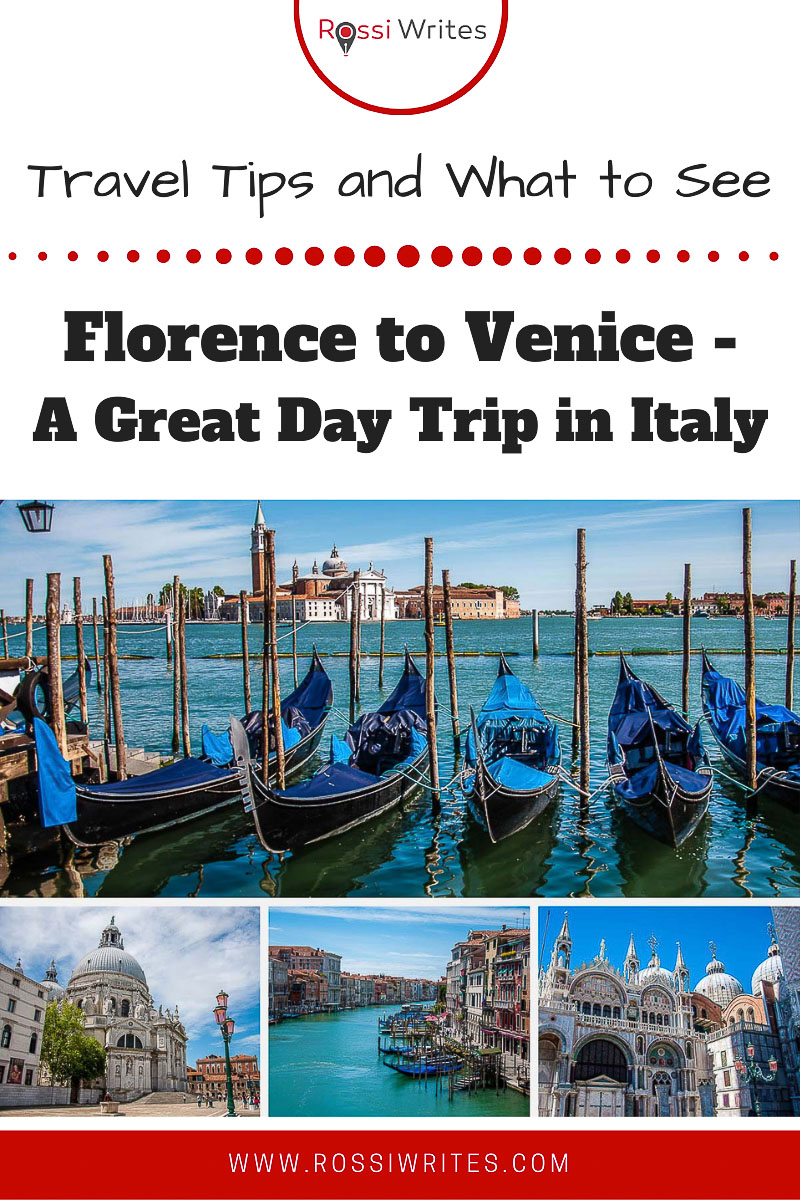
Sharing is Caring
Help spread the word. You're awesome for doing it!

Should I Travel To Venice Or Florence – Which Trip Is Better?
Home > Blog > Should I Travel To Venice Or Florence – Which Trip Is Better?

Italy is one of the most popular travel destinations and it’s not hard to see why. With ancient ruins, cultural wonders and incredible food, it has everything one could desire when it comes to a vacation destination. However, establishing which Italian city to visit presents its challenges.
Florence is the better choice because it offers a much more authentic experience and has a longer shoulder season, which means fewer crowds. However, if you want to explore historic wonders and go island hopping , then Venice is the choice for you.
In this article, we compare and contrast these Italian hotspots to help you decide whether to visit Venice or Florence. For both cities, we discuss the best times to visit, the landscape, cultural attractions, local cuisine and nightlife, providing a full breakdown of what you can expect in Florence and Venice.

How Far is Venice from Florence?
The distance between Venice and Florence is around 160 miles when travelling by car, but depending on your mode of transport this can vary slightly. You can get from Florence to Venice by train, as both cities are very well connected via Italy’s rail network. A high-speed train service can get you from Florence to Venice in approximately 2 hours.
Alternatively, you can take a bus to get between them, but this could take longer depending on the route. You can also opt to fly between Venice and Florence as they both have large airports . However, when factoring in cost and sustainability, it is much more effective to travel between them by other means. If you want to visit both Venice and Florence on an amazing Italian vacation, be sure to check out our 9 day Rome, Florence and Venice tour , where all transport is handled for you by our expert team.
The Best Time to Visit: Florence vs Venice
The best time to visit Italy will largely depend on your own preferences and desires. Florence and Venice have similar tourist seasons, with both getting very crowded during the peak summer months of July and August. It is advisable to visit Venice or Florence during the shoulder seasons as there are fewer crowds and cheaper prices.
However, the best time to visit these Italian cities is slightly different and we expand on each of them below.
The Weather in Florence
The best time to visit Florence is during springtime, between April and June . The weather in Florence during this time is much milder, with flowers bursting into bloom adding to the atmosphere. Average daytime temperatures in Florence range from 59°F to 77°F, which is perfect for exploring museums and visiting the lush gardens.
The shoulder season in Florence is also much longer than in other parts of Italy as it extends into September and October . During fall, Florence enjoys pleasant weather and fewer tourists. This is one of the best times to visit Florence if you want to enjoy outdoor activities or explore the verdant vineyards of Tuscany.
The Weather in Venice
Much like Florence, spring is one of the best times to visit Venice as summer can bring scorching heat to the lagoon. The weather is crisp with the promise of summer and tourists have yet to fill up the narrow alleys and canals. Temperatures in April and June in Venice range from 57°F to 72°F, which is ideal for exploring the city.
It is also worth noting that Venice has a significant flood season, known as ‘acqua alta’. This period of high water lasts from October to January, with November having the highest chance of flooding. You should avoid visiting Venice around this time of year as it could severely impact your travel plans and always check local weather forecasts.

Italian Landscapes: Venice vs Florence
Venice and Florence are some of the most popular cities in Italy, with each boasting distinct features which add to their charm. They have very different landscapes as Venice is on the Adriatic coast and Florence is landlocked, but both are brimming with beauty.
Venice – The City of Canals
The most striking feature of Venice is its iconic canals and waterways. The main thoroughfare is the Grand Canal, which is lined with historic buildings and palaces. This historic architecture dominates Venice’s skyline, with Gothic and Renaissance buildings rising directly from the edge of the glistening water. There are also some examples of Byzantine architecture, which makes the experience much more varied when compared to Florence.
The benefit of visiting Venice is that you can explore its many islands , which offer a welcome escape from the bustling city. You can take a tour of the Venetian Lagoon and visit incredible sites like Murano, which is famous for glassmaking, and Burano, which has colourful houses and incredible photo opportunities.

Florence – The Gateway to Tuscany
Similar to Venice, Florence is made up of historic buildings and landmarks which make it one of Italy’s most beautiful cities. The compact city center is filled with some of the most famous landmarks in Florence, such as the Florence Cathedral and the Palazzo Vecchio. The Arno River flows through the city and can be crossed via the iconic Ponte Vecchio.
The buildings in Florence are heavily influenced by the Renaissance, as this is the supposed birthplace of the historic movement. Tourist attractions like Pitti Palace and the Medici Chapels showcase the city’s fascinating artistic heritage. These classical designs can be found all over Florence which makes it a great place for sightseeing in Italy.
Surrounding Florence, visitors can explore the rolling hills of Tuscany . You can view this lush landscape from Giotto’s Campanile and get some mesmerising photos. Alternatively, Florence is well connected to other towns in the region meaning you can easily embark on vineyard tours and day trips to destinations like San Gimignano.

Culture & History: Florence vs Venice
Both Venice and Florence are brimming with cultural experiences and historical sites, which makes them excellent destinations on an Italian tour. However, these cities showcase very different artistic styles and cultural influences. Florence is synonymous with the Renaissance and is famous for producing artists like da Vinci, whereas Venice has more Gothic styles in architecture.
Below, we highlight the different cultural and historical highlights of Florence and Venice to help you decide which city is best for you.
Florence – An Art and History Lovers Delight
If you love exploring artistic heritage while on vacation then some of the best things to see in Florence are the exceptional collections of the Uffizi and Accademia Galleries . Many masterpieces from the Renaissance are housed in these historic institutions, making them great places to visit for those who want to learn more about Florence’s artistic legacy.
One of the most important elements of Florence’s history is the influence of the Medici family. Starting as wealthy merchants in the 15th century, the Medici family were patrons of the arts and contributed heavily to the flourishing of Florence during the Renaissance. Sites like the Medici Chapels and the Palazzo Medici Riccardi stand as testaments to their influence and impact on the city.
Alongside its artistic and historical offerings, one of the best things to do in Florence is to visit the elegant Florence Cathedral (Duomo). The iconic dome immediately draws the eye and is a symbol of Florence. On your visit, you can also explore the Baptistery and Giotto’s Campanile to learn more about Florence’s architectural history.

Venice – Where Romance & Architecture Collide
While Florence has some impressive landmarks, Venice is not much different. Top attractions in Venice like St. Mark’s Basilica and the Doge’s Palace offer tremendous insight into the city’s history and culture. The ornate details of these buildings showcase the wealth and influence that Venice enjoyed when it was a powerful maritime republic.
Another of Venice’s landmarks that offers amazing cultural insight is the Rialto Bridge. Here visitors can take in some of the best views of the Grand Canal and explore an exciting array of shops and cafes to connect with locals. It is also visually breathtaking, with stone reliefs and statues adorning its features for the perfect scenic experience.
It’s no secret that Venice is one of the most romantic places in Italy. The meandering canals and narrow lanes, plus the gorgeous architecture at every corner create a truly enchanting atmosphere that is perfect for couples visiting Italy. Be sure to explore Venice’s hidden gems on a gondola ride for a more authentic cultural treat.

Cuisine: Florence vs Venice
The main difference between the cuisine of Florence and Venice comes down to their locations. Florence is known for its decadent dishes that are inspired by the rustic Tuscan hills, while Venice takes full advantage of its coastal position with extravagant seafood. They are both excellent destinations for foodies and we dive into the details below.
Florence – Enjoy the Bounties of Tuscany
Although the weather in Florence in November may not be as inviting as the warm summer months, this is a great time to visit for sensational culinary experiences . The harvest will be in full swing by this time meaning you can enjoy artisanal delicacies, like truffles and olive oil. Florence also gets some of its best wines from Tuscany and you’ll often see locals sipping on glasses of red Chianti.
We highly recommend trying Bistecca alla Fiorentina, a juicy steak seasoned with olive oil and rosemary. It’s a classic Florentine dish that has to be tried on your visit. Other foods in Florence that are worth sampling include, Ribollita (a hearty Tuscan soup) and Lampredotto (a sandwich filled with slow-cooked beef).
Venice – Savour the Freshest Seafood
Venice’s location on the Adriatic Sea has heavily influenced its cuisine, with fish and other seafood dominating its culinary offering. Popular dishes in Venice include Risotto al Nero di Seppia (squid ink risotto) and Sarde in Saor (sweet and sour sardines). Another staple food in Venice is Polenta, a cornmeal-based dish that can be enjoyed hot or cold.
The best food in Venice can be found in authentic trattorias, where you can try unique dishes that locals love. The San Polo area of Venice has a fabulous selection of restaurants, many of which source their produce from the lively Rialto Market. We’d also suggest that you avoid dining in tourist-heavy areas, as your experience will be muted in comparison.

Nightlife & Entertainment: Venice vs Florence
While nightlife in Italy may not appeal to every visitor, Venice and Florence have a fabulous evening scene which makes them great places to explore once the sun goes down. Those seeking thrilling bars and sumptuous beverages will find Florence fulfils their needs while travelers seeking a more relaxed evening will be blown away by Venice.
Venice – Opera and Aperitivo
There is some incredible nightlife in Venice that will suit a variety of travellers. Whether you wish to visit the best bacari bars or experience cultural showcases, there is something for everyone in the City of Canals. With a strong aperitivo culture, you can start the evening early and try some incredible cocktails.
Some of the best nightlife in Venice can be found in Campo Santa Margherita, a spirited square in the Dorsoduro district. It’s a popular evening spot for both locals and tourists alike, with various bars and outdoor seating. The atmosphere is truly energetic and you can enjoy comfortable conversation alongside live music.
Those seeking evening entertainment that doesn’t involve bar hopping should visit the Teatro La Fenice Opera House. This historic venue hosts countless operas, ballets and classical music shows which are an extravagant way to spend an evening in Venice. They have an extensive schedule, so they are guaranteed to have something that will pique your interest.

Florence – Piazzas and Parties
The nightlife in Florence is mainly centered around its historic Piazzas, which come to life in the evening. There are a variety of bars and clubs which make for perfect evening entertainment in Florence and cater to a range of tastes. It is much livelier than Venice which enjoys a more relaxed and intimate atmosphere.
Piazza Santa Croce is a vibrant square surrounded by historic buildings. In the evenings, many come here to meet and enjoy drinks at the numerous bars and cafes. There are a variety of different venues here, including jazz bars and clubs with themed parties and acclaimed DJs, so you are certain to find somewhere special.
Likewise, Piazza Santo Spirito in the Oltrarno district is a haven for anyone who wants to enjoy the brilliant bohemian atmosphere. There are several bars surrounding the square, including quirky cocktail bars and laid-back blues bars with live music. Located near the square is the Blob Club, one of the top nightclubs in Florence and the premier place to dance the night away.

Both Venice and Florence have a wealth of attractions and sights that are certainly worth experiencing, which makes them rather hard to compare. They both have incredible architecture and historical sites which allow visitors to experience their rich culture.
However, the main differences between them come down to their locations. Florence is ideal for those who want to explore Tuscany and avoid the summer crowds. It also has a much livelier evening scene which is perfect for visitors who enjoy nightlife.
On the other hand, Venice is better suited to travelers who want to discover the different islands and make the most of the coastal cuisine. It provides a more laid-back evening experience and has a plethora of historic sites that are more varied than the ones found in Florence. Nevertheless, a visit to either of these Italian cities will leave you with fond memories and a yearning to discover more.
Thinking about a show stopping vacation to Florence or Venice? Get in touch with our experts at Italy4Real for friendly advice and bespoke itineraries.
About the Author

Rem Malloy started Italy4real back in 1995 with his mother, Deborah de Maio.
He specialises in Italian tours as well as customised tours to France, England, Ireland, Germany, Switzerland, Greece and Spain. He was also featured in the Travel Channel show Mysteries at The Museum in 2016.
Rem has family in Italy and his mothers home town is Cava di Terrani, near the Amalfi Coast. The family has a street named after them in Sorrento, Via Luigi de Maio; a relative who was mayor of Sorrento.
Other Blog Posts You Might Like

Where to Stay in Venice: The Best Areas and Neighborhoods

When is the Best Time to Visit Florence?

When is the Best Time to Visit Venice?

What to Do in Florence for 3 Days

Unlocking the Secrets to Snagging the Best Airfare Deals to Europe

The 5 Best Day Trips from Florence

Florence or Venice: Which Italian City to Visit?
Last Updated on April 13, 2023
by Audrey Webster
Disclaimer: This article contains affiliate links. That means if you click a link and make a purchase, we may make a small commission. As an Amazon Associate we earn from qualifying purchases. For more information, see our privacy policy.

Florence and Venice are two of the most popular cities in Italy. Venice is known for its historic canals and glass-blown artwork while Florence is famous for its architecture, wine region, and food. If you have a finite amount of time to explore Italy, you might find yourself wondering whether to visit Florence or Venice.
Florence might be your choice if you’re an art and history lover, Venice might be the better option if you’re after a romantic escape. However, both cities are fascinating and they have characteristics that make visiting each one a very unique experience.
Keep reading for a list of everything you need to know when deciding whether to visit Venice vs Florence.
Table of Contents
Centrally located in Italy, Florence is the largest city in the Tuscany region. It’s well known for food, history, and culture, making it a favorite destination for tourists. Florence is also the gateway city to exploring the wine regions and natural spaces of Tuscany.


Accessibility
If you’re arriving by train, you’ll come into Florence through the Stazione Santa Maria Novella. There are other train stations in the city, but this one is the biggest and most centrally located, so it’s probably where you’ll hop off to begin your Florence adventure. You can view schedules here.
The Florence airport is about five miles from the city center and can be accessed by taxi, bus, tram, or rental car.
Taxis are available in the city center, but there is no rideshare service like you’d find in other Italian cities. If you have a rental car (you can find one on Rentalcars.com ), you won’t be allowed to drive in the center of Florence. Those streets are reserved for residents only.
Most of the main attractions in Florence are accessible by foot. Anywhere from five to twenty minutes of walking will take you throughout the main neighborhoods. It’s also the best way to stumble upon hidden gems, find quaint cafes, and wander into local artisan shops.
Navigating Florence is usually easy with clearly marked signs and an intuitive layout, however, you should still use a map or GPS to help navigate. Overall, getting around Florence is easy and affordable.

Affordability
The busiest months in Florence are during the summer. You should expect prices across the board to increase from roughly June through August and be more affordable if visiting Florence in winter.
When it comes to lodging and eating in Florence, you can really spend any amount of money.
However, Florence is generally more budget-friendly for travelers than Venice. Many activities are affordable and there is a lot to see just walking around the city, which is entirely free. If you opt for a high-end visit to Tuscany or private tours, expect to pay more for your stay in Florence.
It’s also worth noting that Florence has more variety in terms of what kind of experience you can have. For example, you have more flexibility to splurge in one area and save in another. You will probably visit nicer restaurants and stay in nicer accommodations in Florence for a lesser price than Venice.
Florence is also a larger city, which grants its visitors more options when they’re deciding where to eat. If you wander from the tourist-oriented city center, you will find cheaper lodging and dining.

Things To Do In Florence
One of the biggest differences between Venice and Florence is the sheer number of things to do. You could easily spend several days in Florence , exploring the city and Tuscany, and have plenty to see and do. It’s very worth your time to spend at least two days getting to know Florence with another day spent venturing into the region.
The Cathedral of Santa Maria del Fiore is by far the most stunning of attractions in Florence. This impressive cathedral stands out against the skyline and sits in the middle of the city. You can go inside the cathedral, but expect to wait in a long line unless you visit as soon as it opens. You can organise a guided tour here.
Ponte Vecchio is a classic spot to visit while wandering Florence. This medieval bridge is lined with colorful jewelry shops with excellent views of the city and river.
Lovers of art museums will find themselves right at home in Florence. The Uffizi Gallery, housing Renaissance masterpieces throughout the ages, is the most popular. You can buy tickets here.
The Accademia Gallery, where Michelangelo’s David lives ( pre-book tickets here ), and Pitti Palace ( pre-book tickets here ) are two other main museums in Florence, but there are many more. While wandering the city, you can also expect to come across pop-up exhibits for various artists. Florence has a rich history of art, artists, and architecture.

Aside from these, make sure you visit Palazzo Vecchio, Piazza della Signoria, Basilica of Santa Croce in Florence, and Piazza del Duomo. There are gardens, vegetable markets, science museums, plazas, and even tombs to explore.
If you have time during your visit to Florence, take a day trip to Pisa , and a tour of Tuscany. Whether you’re a lover of wine or not, this famous wine region of Italy is beautiful with rolling green hills and stunning vineyards.
You can learn about the history of wine and olive oil production in the country. Pisa is just a short train ride away or can be visited on a guided tour.
From the train station in Pisa, walk about twenty minutes to reach the Leaning Tower of Pisa and surrounding museums. These are two iconic destinations that are easily accessible from Florence.
You can also take day trips to cities like Lucca and Siena if you have the time, as well.

Where to Stay in Florence
Hotel Bellavista – This mid-range hotel is a great option for visitors looking for a comfortable and convenient choice in the Tuscan capital. Located close to the train station within easy walking distance of all Florence has to offer, they have a range of different rooms available and an option to include breakfast.
25hours Hotel – This luxury hotel is a great choice for those looking for a plush stay in Florence. They offer a number of rooms perfect for couples looking for a romantic escape. There is also breakfast included in the nightly rate and there is a fitness centre, restaurant and bar on site.
Ostello Bello Firenze – If you’re looking for a great social atmosphere or are travelling on a tight budget, this highly-rated hostel is an excellent option. They have both dorms and private rooms available, good common areas and a fantastic location for exploring the best Florence has to offer.
Not quite what you’re looking for? Click here to browse more Florence hotels!

Venice is arguably one of the most famous cities in Europe. Known as the “City of Canals”, Venice is filled with beautiful architecture, gondolas, and a fascinating history. It has over 118 islands that make up the city, making it one of the most interesting cities to explore on foot.
Accessibility
The easiest way to reach Venice is by train at the Santa Lucia Train Station. From the train station, you can easily walk to your accommodation.
There is a small airport, Marco Polo Venice Airport, that you’ll have to take a bus or boat from to get into Venice proper. You can book a bus here or a boat here.
Getting around Venice is as unique as the city itself. In short, there are three main ways to get around Venice: buses, walking, and vaporettos.
Walking tops out as the best way to get around Venice. The walk from Santa Lucia to St. Mark’s Square (Piazza San Marco) is usually 20 – 30 minutes. When exploring Venice by foot, it’s wise to have a map or GPS at your disposal.
The streets are relatively well-marked, but they twist and curve to create a maze-like city. With all the narrow alleys and random dead ends, it’s easy to get lost. That said, Venice is one of the coolest cities to get lost in.
Buses are mainly to reach Venice from the mainland. Once in Venice itself, you won’t see any cars. Instead, most people use vaporettos to get around. These are essentially water buses that go between all the main points of interest throughout Venice.
It connects the six areas of Venice as well as the other island in the Lagoon. Purchasing single-ride tickets can add up very quickly. Instead, consider buying an unlimited multi-day transportation pass.
The other ferry option is the traghetto. This is a lesser-known option, but worth it for the more affordable price point. It helps visitors cross the Grand Canal easily and cheaply, costing around a quarter of the price of a vaporetto ticket.
Water taxis and gondolas are the two most expensive ways to get around the city. Gondolas are mainly tourist attractions, running from €80-100 for half an hour. Water taxis can transport up to ten people, but tend to be spendy and the prices usually jump at night.

Venice is generally more expensive than Florence. Unsurprisingly, Venice sees millions of visitors every year–more so than other parts of Italy. It’s because of this that prices tend to be higher.
Venice is also a much smaller city compared to Florence, so there are fewer options for lodging. This leads property owners to increase the per night cost of a room to sell to the tourists willing to pay the most.
Similar to Florence, restaurants, cafes, shops, and accommodations near St. Mark’s Square will have higher prices than other parts of Venice. However, expect to pay more for nearly everything in Venice than Florence.

Things To Do In Venice
Venice is a historic and elegant city with plenty of sites to see. You’ll probably recognize many of the highlights from their appearances in pop culture.
Start with the Rialto Bridge. This intricately-designed marble footbridge spans the Grand Canal. It’s a great place for a view of the Grand Canal, especially for sunrise or sunset.
St. Mark’s Square is the largest and most popular public square in Venice. It’s surrounded by shops and restaurants while being home to the stunning St. Mark’s Basilica. You can buy skip-the-line tickets here.
While exploring Venice, you’ll want to make sure to visit Doge’s Palace and the Bridge of Signs. The palace boasts the Venetian Gothic style and was historically the palace of the Doge of Venice, a high authority figure in the former Republic of Venice. You can buy tickets here.

It dates back to 1340. The connecting Bridge of Sighs is a white marble bridge built high above the canal between the Doge’s Palace and a prison. The bridge was built to transport prisoners from interrogation rooms in the palace to their cells in the prison.
Those who love the arts will appreciate the beauty of the Teatro La Fenice and enjoy wandering the art collection at the Peggy Guggenheim Collection of modern art.
If you have an afternoon to spend venturing out of the center of Venice, hop on a vaporetto to visit Burano or Murano. These little islands are known for their lace and glass-blown art, respectively.
They are colorful and charming parts of Venice that are well worth a few hours of your time and just a short ride from the main part of Venice.
If you have a few days to spend in Venice, you could also opt to go on a day trip to nearby Verona or go wine tasting in the famous Prosecco region.

Where to Stay in Venice
Riva del Vin Boutique Hotel – Situated within reach of the iconic Rialto Bridge, this lovely boutique hotel is perfect for those after the ideal romantic escape in Vence. There are a handful of chic and comfortable rooms available, a bar on site, and a great breakfast included in the nightly rate.
Ca’ Angeli – Located in the central San Polo neighborhood, this wonderful hotel is an excellent choice for those looking for a luxe place to stay in Venice. They offer only a handful of beautiful, clean and comfortable rooms and they also have a great breakfast available each morning.
Combo Venezia — This hostel in the cool Cannaregio neighborhood is a great choice for budget and solo travelers to Venice. As one of the city’s highest-rated hostels, they have both private rooms and dorm beds available and great shared spaces and self-catering facilities.
Not quite what you’re looking for? Click here to browse more Venice hotels!

Venice vs Florence: The Verdict
So, should you visit Venice or Florence? The two cities each have their own unique characteristics that make them memorable, however, there are several differences that might make one better than the other for your trip to Italy.
If you want art, history, and other cultural museums, Florence is your place. Here, you’ll generally find more to do, especially if you plan a day trip or two out of the city. Florence also had more options for incredible food due to being a larger city.
Those traveling on a budget should head to Florence as well. Again, because Florence is a larger city with more options for lodging and dining, there will be more flexibility for all budgets.
If you find yourself wanting a city that captures the romance that Italy is famous for, go to Venice. With the canals, music, gondolas, and architecture, you are bound to feel the warm sentiments that come from wandering these picturesque streets.
When it comes to crowds, Venice is almost always packed with tourists. The city receives millions of visitors every year from all over the world. This, coupled with the narrow streets and limited space, quickly makes Venice incredibly dense with tourists.
Florence also sees a lot of visitors, especially during the summer months, but is more spread out, so it won’t feel nearly as crowded as Venice. It’s easier and cheaper to get around Florence, with more options for exploring small towns and regions around the city.
Whether you should visit Florence vs Venice should be based on how much time you have, budget, and the activities you’d like to do. Florence has more to do while Venice is the romantic, picturesque pocket of Italy you’ve seen in movies. No matter which city you choose to visit, it’s certain to be a trip you won’t forget.
Are you trying to decide between visiting Venice or Florence? Have any questions? Let us know in the comments!

Related Posts:

The Perfect 2 to 3 Days in Bologna Itinerary

Milan or Rome: Which Italian City to Visit?

Is Rome Expensive? A Rome Trip Cost Guide

About Audrey Webster
Audrey Webster is a writer for The World Was Here First. She is an Oregon native who has visited countries across the globe and currently spends her weekends exploring the Pacific Northwest and surrounding states. Her approach to traveling combines exploring famous tourist sites and wandering off the beaten path to discover new destinations.
Nice guide ! Only one clarification.. Venice is not so smaller than Florence… The city center of Venice is much larger unlike the Florence ones, where you can walk from the train station to the major square in 10 min. (in Venice you have to walk 30/40 min and there is also the lido, murano and burano islands.). And you have not mentioned the large part of the main land of Venice, wich is the suburban area where a lot of tourists can book cheaper rooms and find other modern museums. Hope my opinion can be usefull for anyone 🙂 Btw, thank you for you amazing work as usual!! 🙂
Leave a Comment Cancel reply

The Ultimate 7-Day Rome-Florence-Venice Itinerary by Train
A trip from Rome to Venice through the Tuscan hills of Italy is fantastic for families, couples, solo travelers, and literally anyone ( and their mama ) visiting Italy for the first time.
What’s more, this 7-day Rome-Florence-Venice itinerary hits a lot of the major historic and art-rich places we learned about in school, doesn’t break the bank, and is great all year round.
* This post may contain affiliate links from which I earn a commission (for more info, read my disclosure ). As an Amazon Associate, I earn from qualifying purchases.
* I try to keep the information on this blog as updated as possible, but I still recommend consulting the latest prices, opening hours, and other details on the official website of each site, hotel, and tour, as well as checking the updated public transport routes and timetables.
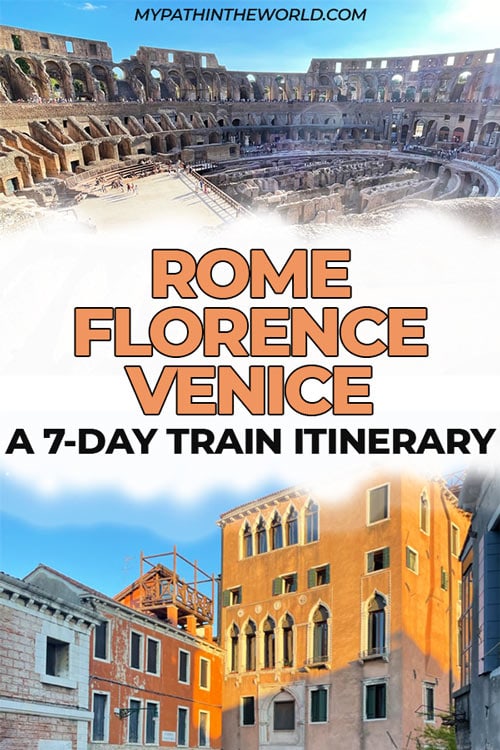
Table of Contents
Itinerary Overview
I’m Mariana, and I’ve spent months traveling through Italy, hiking in the Dolomites, visiting the sites, and drinking Aperol on as many Italian beaches as possible.
I’ve also done this Rome to Venice route a few times, and from my experience, here’s the best route and time in each place:
- 3 Days in Rome – Vatican, Colosseum, Trevi Fountain, Roman History
- 2 Days in Florence – Cathedral, Best Art Museum in Italy, Michelin Experience, a day tour to San Gimignano & Leaning Tower of Pisa
- 2 Days in Venice – Gondola Ride, Basilica and Palazzo, Glass Blowing
Highly-rated accommodation in Rome: Domus Æterna – Re di Roma or D.R.Rome Spanish Luxury Suites .
Highly-rated accommodation in Florence: Atelier delle Grazie , San Giuliano Inn , or B&B Stupido Hotel .
Highly-rated accommodation in Venice: Venice Suite Dorsoduro or Palazzetto Barnaba .
My favorite time to visit Italy is in the spring and autumn when the vineyards are showing off.
Surprisingly, this whole trip is best done via train, and that’s how I recommend it. Renting a car would actually be more of a hassle on the tiny and busy streets of all these cities, and the train system is so cheap, nice, and well-connected, it would be a shame not to use it.
Book your train tickets in advance on Omio (formerly GoEuro).
So let’s jump into what to do and see, a few local tips for each city, and my travel recommendations.
A 7-Day Rome-Florence-Venice Itinerary
You can actually do this route starting in Rome or Venice (Venice-Florence-Rome), as both have great airports and train stations connecting each other. I’ve always started in Rome, so this is the way I recommend it.
Day 1: Arrive in Rome
I’m pretty sure Rome is the most visited city in Europe, and so there’s a reason why I recommend at least 3 days (minimum) in the city center.
Rome is a fantastic blend of historical sites, art, beautiful people, and culinary experiences that make it a great start to the trip.
I’m going to share the top things to see today, but remember to take time to simply enjoy the “dolce vita” – the sweet life – that Rome preaches:
1. Pantheon: This ancient temple, now a church, is renowned for its perfect proportions and its oculus, an opening in the dome that shines light inside the interior beautifully. You will have to cover your shoulders for this one! You can also book a guided Pantheon tour.
2. Trevi Fountain: One of the most famous fountains in the world, the Trevi Fountain is a baroque masterpiece. Tradition says that throwing a coin into the fountain ensures you fall in love with an Italian by the end of the trip. You can explore it with this free Rome walking tour.
3. Piazza Navona: Known for its baroque architecture, street artists, and cafes, Piazza Navona is a charming place to relax and soak in the atmosphere of Rome. This is a great lunch and dinner spot!
4. Spanish Steps: A great spot for people-watching, the Spanish Steps are a famous meeting place and lead to the Trinità dei Monti church (a must-see).
No trip to Rome is complete without stuffing your face full of Italian food. Try dishes like Carbonara, Cacio e Pepe, and authentic gelato. Don’t worry, you can walk it off after!
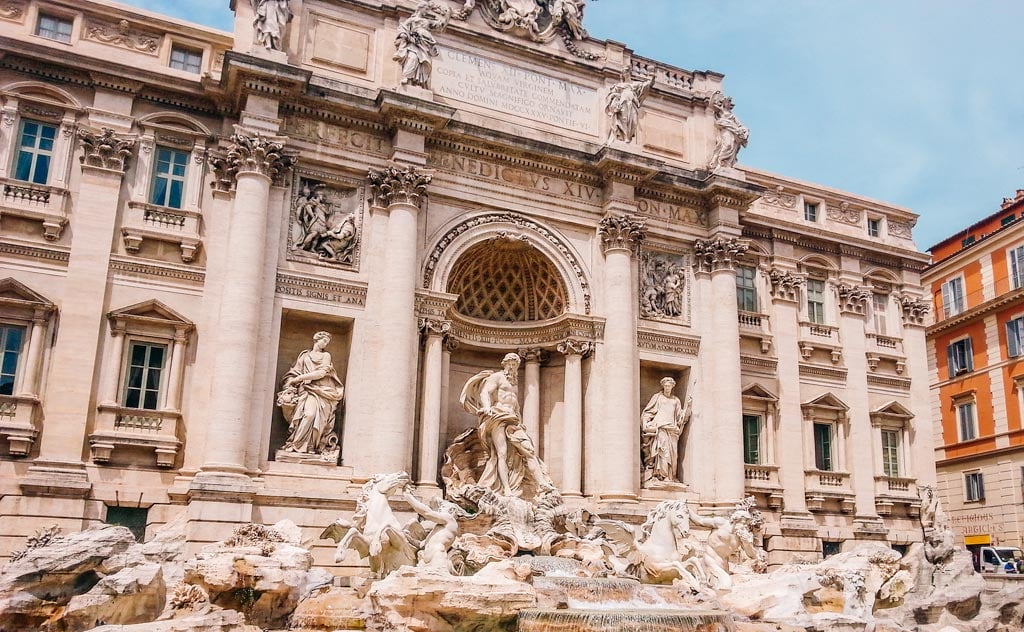
Day 2: Explore the Vatican
Today is all about the Catholic Church. It will take a full day to explore the Vatican City and Trastevere neighborhood across the river, and I highly recommend booking your Vatican tours ahead of time.
Here’s what’s on the daily agenda:
1. Vatican City: Home to the Vatican Museums, Sistine Chapel, and St. Peter’s Basilica, Vatican City is a must. Michelangelo’s frescoes in the Sistine Chapel and the stunning architecture of St. Peter’s Basilica are ‘wow’! Book your tour here or purchase a skip-the-lines ticket .
2. Explore Trastevere: This picturesque neighborhood is known for its narrow cobbled streets, vibrant nightlife, and traditional Roman trattorias. It’s a great area to have lunch and dinner.
3. Walk Along the Tiber River: Especially in the evening, a stroll along the Tiber is a peaceful break from the crazy city streets.
Day 3: Explore Rome
On your last day in Rome, you’re going to do as much as you can during the day, and then catch a late afternoon train (2 hrs) to Florence:
1. Visit the Colosseum and Roman Forum: Explore the iconic Colosseum, a symbol of Rome’s ancient power and engineering. Nearby, the Roman Forum and Palatine Hill ruins are also great! You can book a tour to visit both sites with a guide or get a skip-the-lines ticket .
2. Galleria Borghese: Set in the beautiful Villa Borghese Park, this museum houses a substantial collection of art, including works by Caravaggio, Bernini, and Raphael. Be sure to purchase your ticket in advance .
In the afternoon, take the 2-hour train to Florence’s Santa Maria Novella station and get ready for the next leg of this Italian trip.
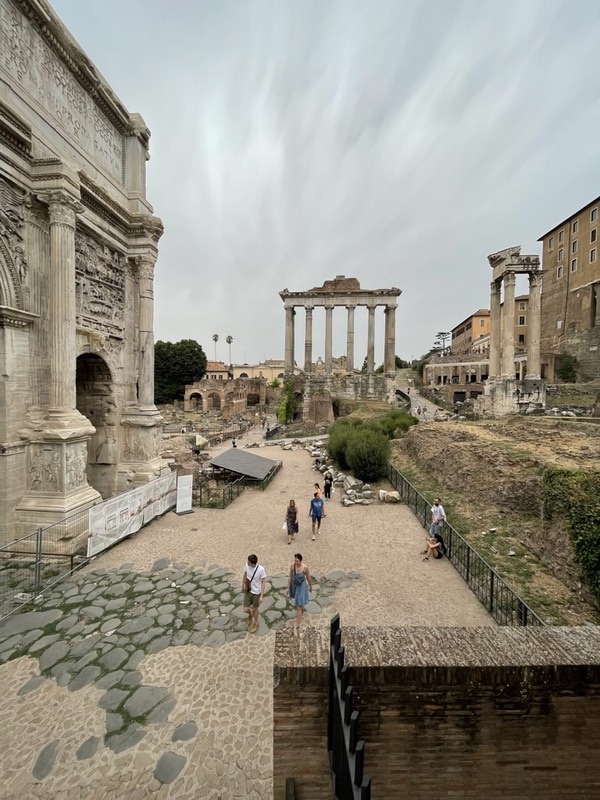
Day 4: Explore Florence
No rest for the wicked! I’ve done all of these things in one day, with the help of 7 espressos along the way:
1. Uffizi Gallery Tour: Home to the world’s greatest collection of Italian Renaissance art, including masterpieces by Botticelli, Michelangelo, and Leonardo da Vinci. You MUST get a ticket and timeslot ahead of time.
2. Duomo – Cathedral of Santa Maria del Fiore: Florence’s most iconic landmark. While you can go in, the lines are insane, so just passing by it and having a coffee is fine.
3. Ponte Vecchio: The oldest bridge in Florence, known for its jewelry shops and picturesque views over the Arno River.
4. Accademia Gallery: Famous for Michelangelo’s David, this gallery also houses an impressive collection of Renaissance paintings and sculptures. You can buy your ticket in advance.
5. Beautiful piazzas: Piazza della Repubblica and Piazza della Signoria. You can explore them with the free Florence walking tour.
6. Boboli Gardens: Behind the Pitti Palace, these beautifully landscaped gardens offer a peaceful escape with stunning views of the city. If you have to skip out on anything, maybe scrap these.
I was shocked by how many Michelin restaurants there are in Florence and was glad to take advantage of the foodie nature of this city. Make a reservation ahead of time – a usual nice dinner with wine goes to €100-150.

DAY 5: DAY TRIP TO PISA & SAN GIMIGNIANO
Really close to Florence is the cutest little Tuscan town, San Gimignano, followed by the city of Pisa further west.
The best way to visit both of these is by booking a tour – this way, you get the history buff tour guide and the transportation. I know it doesn’t seem like a lot, but it’s a full day.
Book your Pisa & San Gimignano tour !

Day 6: Explore Venice
I left Florence on the early morning train and headed to Venice. It took about 2 hours – make sure you grab a coffee and breakfast to go for the train ride.
Venice blew my mind! I don’t know what I was expecting, but it was much more romantic and charming than I realized. Here are the top things to do in Venice, which you can split over the two days:
1. St. Mark’s Square (Piazza San Marco): The heart of Venice, home to the stunning St. Mark’s Basilica, the Campanile bell tower, and the Doge’s Palace. The square is a hub of activity and a perfect starting point for your visit.
2. Doge’s Palace (Palazzo Ducale): Explore this symbol of Venice’s wealth and power, with its magnificent rooms, artwork, and the famous Bridge of Sighs. You can also book a tour of the Doge’s Palace & St. Mark’s Basilica.
3. Rialto Bridge and Market: Visit the oldest bridge across the Grand Canal, a lively area filled with shops, and the nearby Rialto Market, known for its fresh produce and seafood.
4. Grand Canal Tour: Take a gondola or Vaporetto (water bus) ride along the Grand Canal to witness the magic of Venetian architecture and life along the waterways. A gondola ride is about an hour and should cost about €80.
If possible, attend a performance or take a tour of the famous and beautifully restored opera house, and wander the less-traveled paths and canals to discover hidden squares and charming cafés away from the crowds.

Day 7: Explore Venice
On the last day of this Rome to Venice trip, it’s all about going beyond the touristy sites.
For lunch, make sure you sample local goodies like Cicchetti (Venetian tapas), any of the fresh seafood on the menu, and traditional dishes like risotto nero (squid ink risotto) and sarde in saor (sweet and sour sardines).
In the afternoon, take a boat trip to Murano and Burano Islands nearby. Murano is famous for its glass-making, while Burano is known for its lace-making and brightly colored houses. Vaporettos (water taxis) are your friend for these trips. You can also book an excursion.
From here, you can either take the train back to Rome the next morning or fly on to your next destination – or home!

Getting From Rome to Venice
Traveling from Rome to Venice can be done in several ways, each with its own pros and cons. I recommend doing this Italy itinerary by train, but I wanted to show you what’s possible.
✅The best way to do this trip is by train. Italy’s high-speed trains, like Frecciarossa, connect Rome to Venice in about 3.5 to 4 hours, with so many stops along the way to break up the trip – like Florence and Bologna.
Trains are punctual, fast, and allow you to enjoy the scenery without the stress of driving. The downside is the lack of flexibility; you’re limited to the train schedule and routes, and there’s less opportunity for spontaneous exploration.
✅Driving is the most flexible way to get from Rome to Venice. You have the freedom to stop in cute little towns and scenic spots along the way – and there are plenty.
However, driving in Italy can be challenging due to traffic, especially in cities, and parking can be expensive and tough to find.
What’s more, navigating the ZTL (Limited Traffic Zones) in places like Rome, Florence, and Venice requires planning to avoid fines.
✅Flying is the quickest way to travel between Rome and Venice , with the flight time being just over an hour. However, when you factor in the time for airport transfers, security checks, and waiting at the airport, it may not save much time compared to the train.
Also, you miss out on the scenic journey and the chance to visit places between the two cities.
Each mode of transportation gives you a unique experience, so your choice depends on your priorities, whether it’s flexibility, speed, comfort, or the opportunity to explore.

Travel Tips for This 7-Day Rome-Florence-Venice Trip
If it’s your first time in Italy, you might find a few of these surprising. Nevertheless, here are some practical tips to help make your journey smooth:
✔️Plan and Book In Advance: Decide on the places you want to visit along the way. Besides major cities like Florence, consider adding smaller towns and countryside stops, like San Giminiano and Siena.
And for the love of baby Jesus, book your hotels and AirBnBs ahead of time, especially in peak tourist season (which is always).
✔️Don’t Rent a Car: It will actually be more of a hassle on this particular route because the trains are super well-connected, cheap, and nice. What’s more, Venice is a car-free zone.
For little day trips to vineyards and cute little villages, there are amazing small-group tours you can book that give you a bomb-ass guide and handle the transport and entry tickets for you.
PRO TIP: Many Italian cities, including Rome and Venice, have ZTL areas where non-residential vehicles are restricted – there will be signs. If you do rent a car for whatever reason, plan to park outside these areas to avoid hefty fines. In Venice, park at the Tronchetto or in Mestre and use public transport to get into the city.
✔️Pack Right: Bring a little backpack with you at all times, and fill it with your charger (don’t forget the European adapter), a water bottle (especially in the summer), and snacks (which you can buy along the way).
Comfortable walking shoes are a must. So is one cute night outfit, because you’re going to some of the most romantic places in Italy.
✔️Be Flexible: While it’s good to have a plan, be open to spontaneous detours or stops. Some of the best experiences come from unplanned adventures. Like why not skip the Vatican and take a day trip to Pompei or Naples?
✔️Learn Basic Italian: Phrases for greetings, directions, the bathroom, and ordering food will be particularly helpful. And maybe a few curse words, just for fun.
✔️Show some Respect: Dress appropriately when visiting religious sites, cover your shoulders and head in all churches, and be nice when chatting it up with locals. And tip your waiter !
✔️Don’t Be A Tourist: Don’t put your wallet in the back pocket of your jeans, and don’t leave your phone on the table as you eat (like I do in the States), because that makes you an easy target for petty thieves.
That said, Italy is pretty safe, so just apply the same watchful eye as you might in New York City.

FAQ: Rome-Florence-Venice by Train
Is it worth taking a day trip from rome to venice.
Not really. The fastest train from Rome to Venice is just under 4 hours. Driving will take almost 6 hours. And while a flight takes 1 hour, getting to and from the airport, will add a few more hours.
What Are the Best Places to Stop Between Rome and Venice?
I think the top 5 best places to stop on this route are:
1. Florence : Known as the cradle of the Renaissance, Florence is the epicenter of art, architecture, and history in Italy. Visit the Uffizi Gallery to see works by Michelangelo and Botticelli, and don’t miss the iconic Duomo.
2. Siena : This medieval town in Tuscany is famous for its historic center, a UNESCO World Heritage Site. Highlights include the Piazza del Campo and the Siena Cathedral. The Tuscan countryside around Siena, known for its vineyards, is the backdrop to my phone.
3. Bologna : Often overlooked, Bologna is a hidden gem. I love it for its rich food culture (think authentic Bolognese sauce).
4. Verona : Famous as the setting for Shakespeare’s Romeo and Juliet , Verona is a city for lovers. Visit Juliet’s House and explore the ancient Roman arena here.
5. Padua : Before reaching Venice, stop in Padua, known for its historic architecture and art. The Scrovegni Chapel, with frescoes by Giotto, is a highlight. Padua also has a lively market and beautiful botanical gardens, the oldest in the world.
Each of these stops gives you a unique slice of Italian culture and history, making your Rome-Florence-Venice travel itinerary just a bit more authentic.
PRO TIP : Remember to check the opening times of everything and book tickets in advance (trust me!) to make the most of your stops.

Is a Road Trip Through Italy a Good Idea?
Although this itinerary is better done by train, a road trip through Italy is a fantastic idea, especially if you love Italian food and art history, and value the old-school charm of “ dolce vita ” life. More specifically, here’s a few reasons to hit up Italy for a road trip:
Pretty Landscapes : From the rolling hills of Tuscany to the rugged coastlines of Amalfi , a road trip through any part of Italy will showcase some pretty epic scenery.
Rich Culture : Every region has its unique heritage, from ancient Roman ruins in Rome to Renaissance art in Florence. Road-tripping lets you explore cultural gems like the Tower of Pisa, a Tuscan winery, the Vatican, and the canals of Venice at your own pace.
Yummy Food: Italy is a paradise for foodies, from the ragú in Naples to seafood in Sicily. You’ll be shocked to know that Italy is more than just pizza and pasta.
Charming Villages: Beyond the major cities, Italy is dotted with cute little towns and villages, often less visited by tourists. Road tripping (even by train) gives you the freedom to discover these hidden gems and experience the authentic Italian way of life.
Final Thoughts
I’ve spent months traveling through Italy – I’ve tried this Rome to Venice itinerary a few times, and I think the best way to get from one spot to another is by train.
I recommend visiting Italy in the spring or fall months when the tourist crowds are more manageable and it’s not so blistering hot in Italy.
Bio: Mariana Barbuceanu is the owner and author of the Road Trip EuroGuide, a blog that inspires fellow wanderers to explore Europe more authentically through slower travel and digging deeper into the culture of a place. When she isn’t writing about her adventures, she is planning trips for her community and coaching people on how to take that next step toward a much-needed sabbatical.
Related Posts
- Places to see in Central Italy
- Italian piazzas
- Best Italian road trips
- Italy in winter
- Gifts for Italy lovers
- Italy travel quotes
- Romance novels set in Italy
- Books set in Tuscany
- Places to visit in Lombardy
- Places to visit in Piedmont
- Hidden gems in northern Italy
- Best road trips from Milan
About Or Amir
Hey, I'm Or! I'm a passionate traveler with a severe coffee, chocolate, and pastry addiction (or any other carb for that matter). I'm always planning my next trip to Spain, Italy, or any other country in Europe, and my goal is to help you make the most of each destination.
*Your emil address will not be published. By using this form you agree with the storage and handling of your data by this website
Leave a Comment Cancel reply
Save my name, email, and website in this browser for the next time I comment.
Hi, I'm Or!
I'm a passionate traveler obsessed with traveling in Europe and discovering hidden gems in each place I visit. For me, it's not about ticking destinations off the bucket list but experiencing each one of them to the fullest. Read more about me and my story.

You are using an outdated browser. Please upgrade your browser to improve your experience.
- Restaurants
- Best-of Guides
- MICHELIN Guide Ceremony
- My Favorites
- Subscribe to newsletter
- Booking partnership with OpenTable
- Booking partnership with Resy
- USA - English - USD
- In Photos: Every Three Key Hotel in Italy
The ins and outs of the most outstanding hotels in the country.
Italy Venecia Hotels Travel MICHELIN Keys

The Three Key distinction is the highest hotel honor in The MICHELIN Guide. Earning One Key (107 properties) or Two Keys (31 properties) is difficult enough, but only eight hotels received the Three Key distinction in Italy. These hotels excel in all five criteria used to judge hotels by our Inspectors. Here, we thought it fitting to focus on just one of those criteria — the most photogenic of the five — architecture and interior design. Below, take a look at the interiors and exteriors of each of our eight Three Key hotels in Italy. Read also: Every Three Key hotel in Paris Every Three Key hotel in New York City

Aman Venice
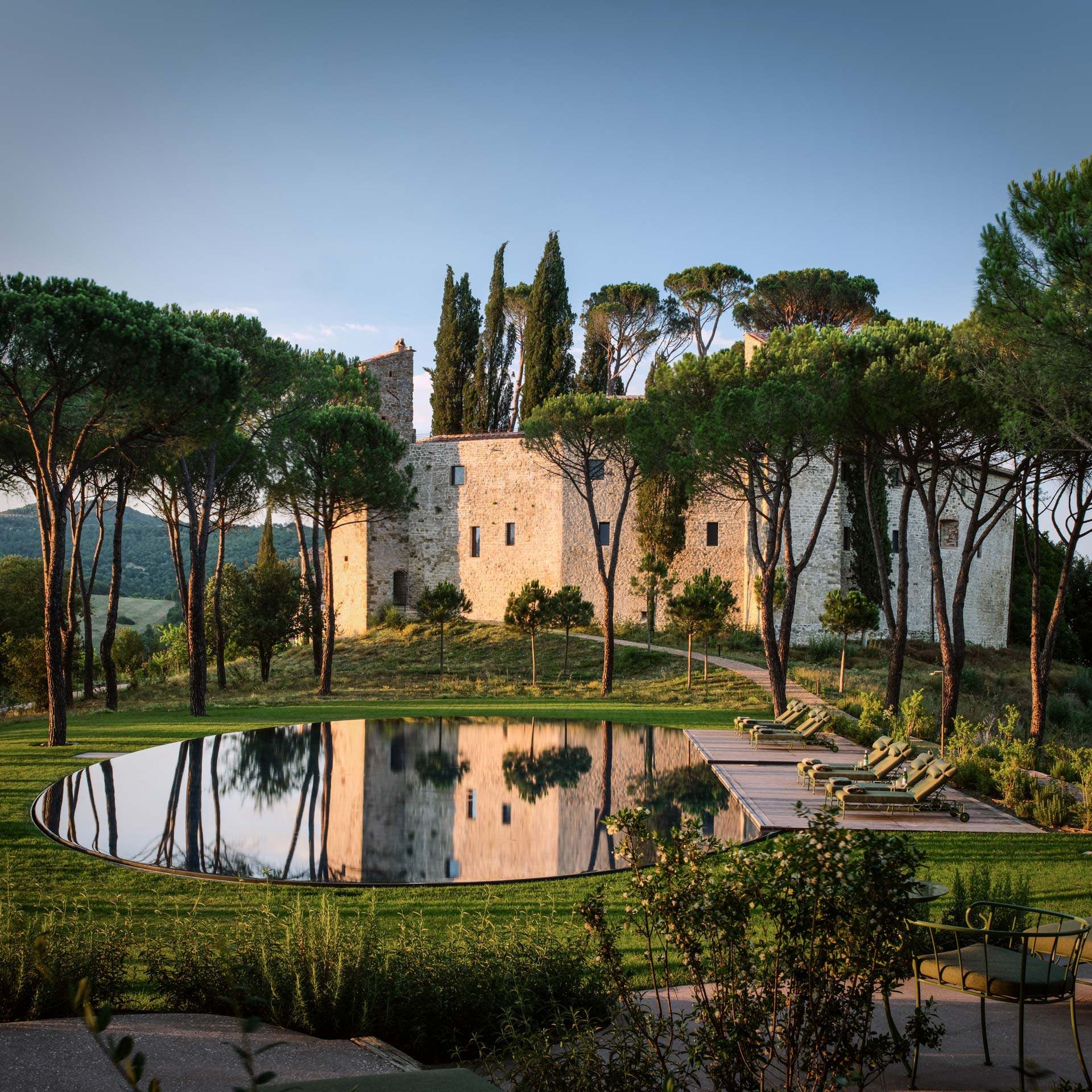
Castello di Reschio

Rosewood Castiglion Del Bosco

JK Place Capri
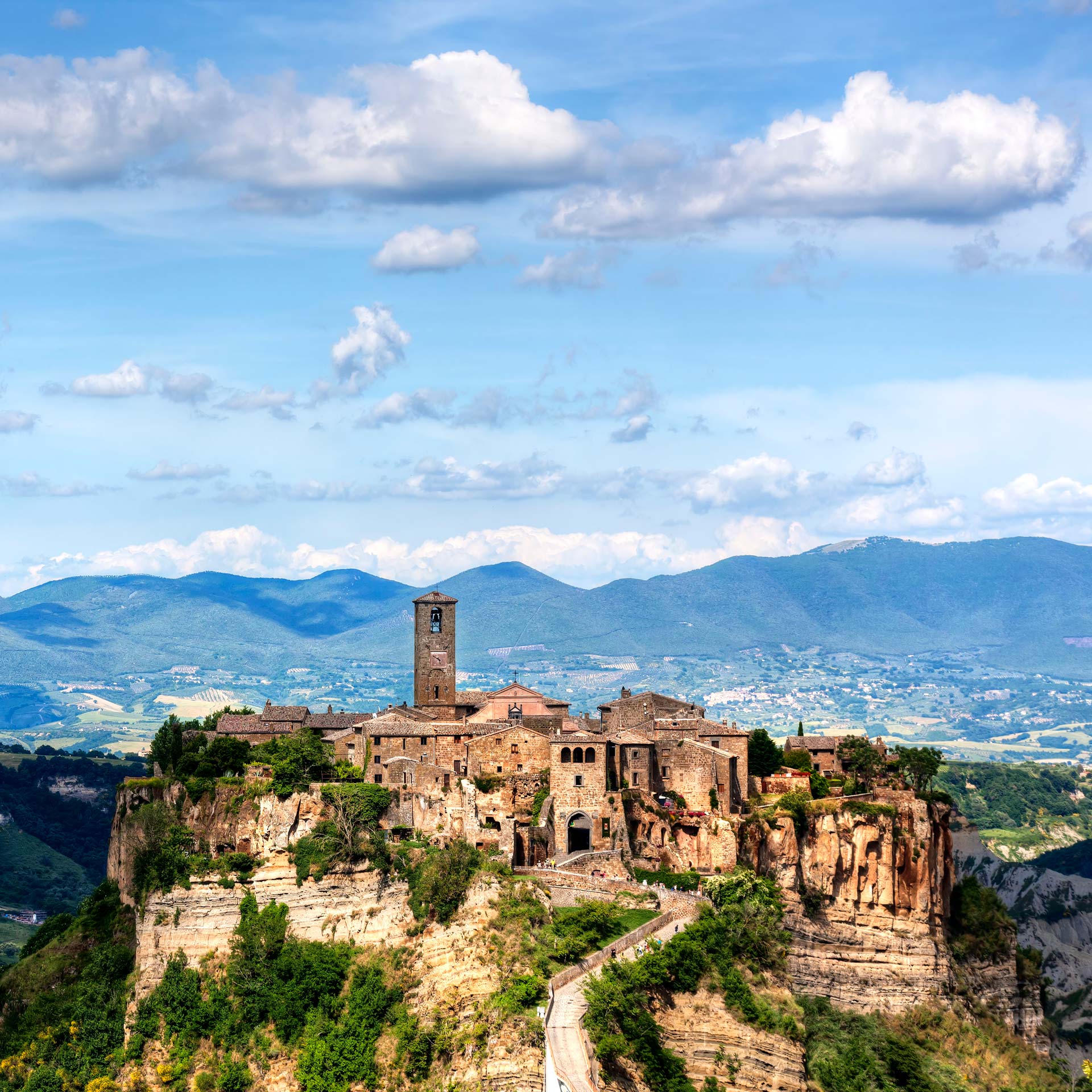
Corte della Maestà

Casa Maria Luigia

Il San Pietro di Positano

Cipriani, A Belmond Hotel
Hero Image: Corte della Maestà — Civita di Bagnoregio

Thomas Keller Talks 20 Years of Per Se and His New York
The chef behind the Three MICHELIN Star staple shares his love of Manhattan.

How to Spend a Weekend in Monterey, California
Discover why this slice of California is at the top of so many travelers' bucket lists.

Ronny Chieng's New York - The Perfect Slice and Haute Sushi
The actor and comedian breaks down his West Village staples.

The Farmhouse Hotels of Southern Italy
A bevy of historic country retreats make their presence felt among Italy's first-ever Key hotels.
Keep Exploring - Stories we think you will enjoy reading

Elevate Your Mother's Day Celebrations with Afternoon Tea at MICHELIN Hotels
How better to honor the woman who does it all for us?

The Key Decision in Tuscany
The sublime magnificence of a castle or the simple charm of farmhouse? In the end, it comes down to the traveler.

High Drama in the Seaside Hotels of the Amalfi Coast
After hotel Key announcements in Italy, the Amalfi Coast shows off its distinguished collection.

10 Key Hotels with 10 Rooms or Less in Italy
Our smallest Key hotels across Italy are overflowing with passion and personality.

The First MICHELIN Key Hotels: All the Keys in Italy
The MICHELIN Guide announces top honors for Italian hotels in 2024.

Palazzo Margherita Is Coppola Family Business
A palazzo in a small town in the south of Italy just earned Francis Ford Coppola his latest accolade.

Castello di Reschio Is a Medieval Masterwork
Castello di Reschio will never be mistaken for a Disneyfied fantasyland. This 1,000-year-old Umbrian castle hotel reflects the artistic vision of one man — and it just earned Three MICHELIN Keys.

Tommy Hilfiger's New York is Bold, Classic, and Luxe
The man who dresses America (and the world) indulges in the best Manhattan has to offer.

Time-Tested Country Escapes Just Outside Paris
Seven historic chateaus, remade abbeys, and the spots that have welcomed city escapees for centuries.

Rosewood Kona Village Breathes Luxurious New Life into Legacy
Ten years after a devastating tsunami destroyed it, Kona Village is back and better than ever.
MICHELIN Guide

Use the app to find the best restaurants and hotels everywhere
Be the first to get news and update about the michelin guide.
MICHELIN Guide selections
The michelin group.
- Terms of Use
- Privacy Policy
- Legal Notice
Display settings
Customize your experience by easily adjusting display settings for territory, and currency to suit your preferences!
Member privileges
The Plus program provides upgrades and amenities at participating hotels. For this hotel, Plus members will receive:
Non-members can add the privileges at checkout through our 30 day free trial, cancellable at anytime.
- Florence Tourism
- Florence Hotels
- Florence Bed and Breakfast
- Florence Vacation Rentals
- Flights to Florence
- Florence Restaurants
- Things to Do in Florence
- Florence Travel Forum
- Florence Photos
- Florence Map
- All Florence Hotels
- Florence Hotel Deals
- Last Minute Hotels in Florence
- Things to Do
- Restaurants
- Vacation Rentals
- Travel Stories
- Rental Cars
- Add a Place
- Travel Forum
- Travelers' Choice
- Help Center
Trouble Buying Train Tickets on Trenitalia - Child Ticket - Florence Forum
- Europe
- Italy
- Tuscany
- Province of Florence
- Florence
Trouble Buying Train Tickets on Trenitalia - Child Ticket
- United States Forums
- Europe Forums
- Canada Forums
- Asia Forums
- Central America Forums
- Africa Forums
- Caribbean Forums
- Mexico Forums
- South Pacific Forums
- South America Forums
- Middle East Forums
- Honeymoons and Romance
- Business Travel
- Train Travel
- Traveling With Disabilities
- Tripadvisor Support
- Solo Travel
- Bargain Travel
- Timeshares / Vacation Rentals
- Province of Florence forums
- Florence forum

Any ideas as to why this is is happening or how to fix? I bought ticket tickets from Rome to Venice without problem.
4 replies to this topic

I just tried to set up a dummy booking on this route for early June and I got the correct fare for two children and three adults. Try entering your name as Passenger #1, then enter the two children, then enter the other two adults (in that order).
Thank you! Will try that on future bookings. I ended up being impatient and just booked on Italo. Hopefully the pricing is similar.
Any difference between the two companies regarding service, ease of boarding or location?
The only difference between Trenitalia and Italo is PRICE. Everything else are minutiae.
Trenitalia often has more trains on routes which it shares with Italo.
My mistake for being impatient! Luckily the price difference was just 8 euros this time. Thank you for the information!
- Retrievers Live TR: Florence, Portugal/Galicia, Paris yesterday
- Trouble Buying Train Tickets on Trenitalia - Child Ticket yesterday
- Wine-tasting venues in Montepulciano? yesterday
- Correct train? Ferry combo? yesterday
- Florence to Rome on Christmas Day? yesterday
- Advanced reservation required / city pass yesterday
- Venice and Florence May 08, 2024
- Itinerary advice/suggestions of towns to see near Florence May 07, 2024
- Uffizi and Accademia in one day? May 07, 2024
- A quick stop at Florence by train May 07, 2024
- 3 nights - Hotel Boccaccio or First of Florence May 07, 2024
- Golf cart tour Florence May 06, 2024
- Taxi fare to airport May 06, 2024
- 3 full days in Florence. Need help May 06, 2024
- Best area to stay? 22 replies
- getting from milan to florence 27 replies
- Getting from Pisa to Florence 9 replies
- Train ride from Venice to Florence, Florence to Rome 3 replies
- Driving Florence to Venice 6 replies
- Renting a car in Florence, near train station 2 replies
- Convent stay 6 replies
- Tickets to climb Duomo 18 replies
- Best place to stay near Florence? 6 replies
- is this an "Official" Uffizi site to reserve tickets? 31 replies
Florence Hotels and Places to Stay
- FAQ - Rental Car return at Florence (Peretola) Airport
- FAQ - ZTL rules with rental car
- FAQ - Luggage Storage
- How easy is it to book Uffizi and Accademia by 'phone?
- FAQ - DAY TRIPS: Lucca, Pisa, Siena, Chianti...
- FAQ - DAY TRIP: Cinque Terre from Florence
- FAQ - Designer Outlet shopping near Florence
- Saving Money on the Train Between Rome and Florence
- FAQ - LAUNDRY in Florence
- Arriving at FCO or MXP: Should I Pre-purchase the Train to Florence?
- What is the cheapest train fare between Florence and Naples?
- Are there direct connections between Florence and Rome FCO Airport?
- Are there direct connections between Florence and Rome FCO Airport? (revised 4/2017)
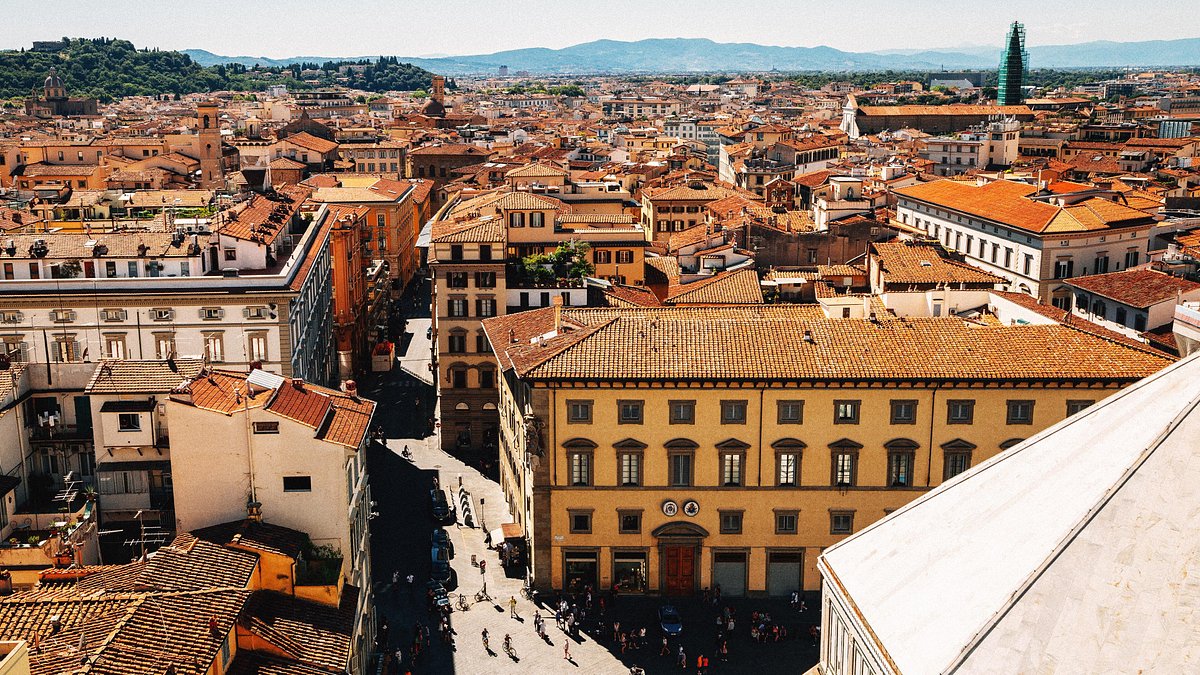
- Share full article

Critic’s Notebook
At SFMOMA, Disability Artwork Makes History
After 50 years, Creative Growth in Oakland celebrates as its artists enter the San Francisco Museum of Modern Art’s collection.
At the San Francisco Museum of Modern Art’s exhibition, “Creative Growth: The House That Art Built,” a mannequin wears an untitled piece by William Scott from 2020 (acrylic paint on suit jacket and pants). Right, a wall-size photo of Creative Growth artists and staff members. Credit... Don Ross, via San Francisco Museum of Modern Art
Supported by
By Jonathan Griffin
Reporting from Oakland, Calif.
- Published May 7, 2024 Updated May 8, 2024
In 1974, Florence Ludins-Katz and Elias Katz — she an artist, he a psychologist — turned the garage of their Berkeley home into an art studio for adults with developmental disabilities. Across California at that time, people with a range of disabilities were being deinstitutionalized, with little provision made for them after their release. The Katzes viewed art-making as a pathway not only to personal fulfillment for disabled people, but also to their integration into a society that valued their work.
Half a century on, Creative Growth — as the iconoclastic and influential studio in Oakland was named — is celebrating its 50th anniversary with an exhibition, “Creative Growth: The House That Art Built,” at the San Francisco Museum of Modern Art.
The exhibition draws from SFMOMA’s half-million-dollar acquisition of more than 100 Creative Growth artworks, the largest purchase by any American museum of the work of disabled artists. The museum acquired 43 more pieces from Creative Growth’s sister organizations in California, also founded by the Katzes: Creativity Explored in San Francisco and NIAD (Nurturing Independence Through Artistic Development) in Richmond.

Time was when such work would have been siloed in collections of “Outsider Art” or folk art. Over the past decade, however, it has been increasingly common to see art by developmentally disabled artists integrated, without contextual fanfare, into group shows or biennials. Cultural institutions, from the Museum of Modern Art to the Brooklyn Museum, have occasionally acquired examples of such work, although it is seldom exhibited except in special displays.
What is happening at SFMOMA is different. The acquisition is part of a partnership with Creative Growth through which the museum, led since 2022 by the director Christopher Bedford, pledges to introduce more art by developmentally disabled people from the three Bay Area organizations into its collection displays, and consequently into the canon of modernist art history.
Tom Eccles, executive director of the Center for Curatorial Studies at Bard College, calls the partnership “unprecedented.” The art historian Amanda Cachia — who writes on disability art — agrees, saying, “The canon as we know it is being reorganized to incorporate the voices of disabled artists who have long been excluded from these narratives. Museums have a long way to go in recognizing contemporary disability art.”
The partnership with SFMOMA, which began in late 2022, is a landmark achievement for Tom di Maria, who joined Creative Growth as its executive director in 1999 and has led the organization to become the most successful and widely recognized studio of its kind in the United States.
The exhibition “Creative Growth: The House That Art Built” opened April 5, showcasing nearly 70 standout works by 11 of the center’s hundreds of current and former artists, alongside a newly commissioned mural in the museum by the acclaimed Creative Growth artist William Scott.
The partnership constitutes the breach of the institution’s high walls that Creative Growth has been striving toward for years. While it may signal a turning point for disability arts, it also comes at a time of change for the organization, as di Maria, 65, looks to retirement and its staff has moved to unionize.
In 2019, di Maria tried to step back from his position as Creative Growth’s leader, first by sharing the position of director, then later moving into a director emeritus role. New appointments did not stay in leadership roles for long. The pandemic complicated matters further, interrupting Creative Growth’s operations. Since December, when the executive director, Ginger Shulick Porcella, left after 12 months, di Maria stepped in once again as interim executive director.
Di Maria tells me that this kind of leadership problem is common in art nonprofits, where long-term directors broadened their job descriptions as their organizations grew. “When they step away,” he said in an interview, “you’re looking for somebody that’s going to be the fund-raiser, the curatorial director, the HR person, the grant-writer, all in one.”
Under di Maria’s leadership, Creative Growth has evolved in ways that make it barely recognizable from the nonprofit he inherited. Its annual budget has risen to $3.4 million from $900,000 in 1999, about a third of which is raised from sales of the artists’ work. (Art sales totaled around $20,000 annually when he joined. When artists sell their work through Creative Growth, the organization takes a 50 percent cut.)
Di Maria has advanced the Katzes’ legacy by pushing to integrate the work made by Creative Growth artists into the mainstream commercial art world. During his tenure, artworks have been acquired by museums including the Pompidou Center in Paris, the Tate in London and the Museum of Modern Art in New York. Two Creative Growth artists, Judith Scott and Dan Miller, exhibited in the 2017 Venice Biennale. Many others have had solo shows at respected commercial galleries across the world.
The sale of artworks by disabled people, di Maria says, is a means of “getting a seat at the table.” Collectors acquire often-inexpensive works, and become invested in the lives of the makers; dealers take notice, and put on shows; prices go up; museum boards promote the work they own to curators; work gets donated to museum collections. Once the art is inside the museum, the real work can begin: changing the way the public values and understands the lives of disabled artists.
On one level, the exhibition — organized by the SFMOMA curators Jenny Gheith and Nancy Lim — presents a social history of disability arts in the Bay Area and the Katzes’ groundbreaking initiatives. This story is told through a well-designed interpretive display in a new gallery called “Art in Your Life,” and in cases of ephemera such as fund-raising letters and event announcements that frame the exhibition in documentary terms.
On another level, however, it is a show of art as accomplished as any in the museum. The first gallery showcases work by three of Creative Growth’s pre-eminent figures, and one emerging talent. Dwight Mackintosh, who died in 1999, was one of the first artists from the organization to win international attention for his drawings. Using felt-tip and colored paint, in his looping hand, he drew groups of translucent figures often surrounded by a distinctive, intermittently legible script.
Mackintosh’s repetitive mark-making rhymes with the intensely overlaid words and shapes in drawings and paintings of Dan Miller, 62, and in an assemblage sculpture by Judith Scott, who died in 2005: a small chair wrapped with strips of fabric and twine, tying in other items including a basket and a bicycle wheel. Meanings are buried deeply in these works.
Do not confuse such practices with art therapy. Just like professional artists who work and rework a set of ideas and motifs, Mackintosh, Miller and Scott spent decades honing private languages, resulting in oeuvres that embody their powerful personal visions.
In that first gallery is also an arresting video by Susan Janow, 43, her first foray into the medium. In “Questions?” (2018), Janow stares into the camera, tight-lipped, while questions are asked of her (in a voice-over, also recorded by Janow), ranging from the banal — “Do you wear a watch?” — to the existential — “Do you trust others easily?” “Who do you miss?” “Where do you see yourself in 10 years?” Her art reveals that her interior life is shaped as much by inquiry as by confident conclusion.
Another highlight of the exhibition is a vivacious untitled abstract painting, from 2021, by the Berkeley-based Joseph Alef, 43. In an exhibition text, Alef explains that nonfigurative work makes it “easier to get all of the emotions out.” These texts admirably elucidate artists’ processes and approaches without disclosing the nature of their disabilities, which might risk skewing viewers’ interpretation of their art.
If some artists choose to share details of their lives through their art, that is their prerogative. Camille Holvoet, 71, who worked at Creative Growth until 2001, makes cheerfully frank, brightly colored drawings of her joys, anxieties and hopes. Created between 1987 and 1998, the pictures on view depict her medications, her fear of public transport, her experience of moving to a new group home, and — poignantly, in this context — a picture of a smiling woman next to stacks of cash and checks: “Making More as Mush Money as a Good Artist, Without No SSI Cuts and No Pay Tax.”
Ordinarily, I am not inclined toward such illustrative artwork. But Holvoet’s pictures achieve one of the most profound aims of the exhibition, and indeed of Creative Growth’s founders: to help disabled artists thrive as individuals with agency and potential. Whether an artist is using creative work to narrate their life story or to transcend their circumstances, making art is a deeply assertive act.
Exemplary is William Scott’s commissioned mural “Praise Frisco: Peace and Love in the City,” part of the museum’s “Bay Area Walls” series. Over the course of his artistic career, Scott, 59, has painted his vision of a utopian San Francisco of the future, a city he calls “Praise Frisco” which incorporates rejuvenated elements of his past. In his mural at SFMOMA, we see smiling, youthful versions of himself and his mother, alongside a spotless depiction of the Alice Griffith public housing development where he grew up. (Also present are green flying saucers, labeled “Wholesome Skyline Friendly Organizations.”)
Three days before this triumphant exhibition opened, di Maria received a letter from Creative Growth staff members announcing their intention to unionize. “Forming a union will help ensure more equitable hiring and pay practices, standardized benefits, greater protections, safer working conditions, and improved procedures around transparency and accountability,” it read.
Di Maria accepted unionization soon after, on April 11. In recent years, staff members at arts institutions across the country from museums to art schools have been unionizing. Sam Lefebvre, a part-time artist aide and member of the union Creative Growth United, told me that high turnover, owing to unsustainable working conditions, can negatively affect the artists, who may form close bonds with studio facilitators, and who often respond best to routine and stability.
At this moment of transition for both Creative Growth and SFMOMA, all eyes are on the future. Museums across the country are working to connect more deeply with their audiences, and by including and celebrating the work of disabled artists in their collections, they will better reflect the lives and experiences of all their visitors.
“One in four people in the United States identifies with disability,” the scholar Jessica Cooley, who writes on disability arts and museum studies, said in an interview. “Disability art and artists are already everywhere, in every collection, making incredible impacts on the art world.” SFMOMA’s partnership with Creative Growth can be seen just as an acknowledgment of the contributions disabled artists have made to art history.
Advertisement

COMMENTS
Tickets cost €21 - €70 and the journey takes 2h 14m. ItaloTreno also services this route every 3 hours. Alternatively, Itabus operates a bus from Florence Villa Constanza Bus Station to Venice Tronchetto Train Station 5 times a day. Tickets cost €11 - €16 and the journey takes 4h 15m. FlixBus also services this route every 4 hours.
Trenitalia Frecce operates a train from Venezia S. Lucia to Firenze S.M.N. hourly. Tickets cost €21 - €70 and the journey takes 2h 13m. ItaloTreno also services this route every 3 hours. Alternatively, FlixBus operates a bus from Venice to Florence every 4 hours. Tickets cost €21 - €30 and the journey takes 3h 30m.
Traveling by train from Venice to Florence is an easy and enjoyable journey. Many Freccia high-speed trains make the 166 mile trip in just 2 hour and 5 minutes. Get ready for a delightfully scenic ride as you travel south from Italy's Adriatic coast through Emilia-Romagna and Tuscany. Your train may stop in Padua or Bologna along the way.
The most direct route between Venice and Florence is the autostrada (highways A13 and E35, specifically), which is a 257-kilometer (160-mile) route that takes about three hours of driving time. ... The best time to travel to Florence from Venice is before or after the summer high season, when transportation will be booked up and, therefore ...
1. From Venice to Florence by Train Ponte Vecchio over Arno River in Florence. The fastest and easiest way to get from Venice to Florence is by train.Climbing aboard a Trenitalia high-speed Frecciarossa train is the best way to travel. Reaching high speeds of 300 kilometers an hour, they can zip between Venice Santa Lucia and Florence Santa Maria Novella stations in two hours and 13 minutes.
Trenitalia Frecce operates a train from Venezia S. Lucia to Firenze S.M.N. hourly. Tickets cost $22 - $75 and the journey takes 2h 13m. ItaloTreno also services this route every 3 hours. Alternatively, FlixBus operates a bus from Venice to Florence every 4 hours.
Venice to Florence by train. It takes an average of 2h 37m to travel from Venice to Florence by train, over a distance of around 127 miles (204 km). There are normally 29 trains per day traveling from Venice to Florence and tickets for this journey start from $10.07 when you book in advance. First train. 05:38.
The cheapest way to travel between Venice and Florence is a bus with an average price of $2 (€2). This is compared to other travel options from Venice to Florence: A bus is $22 (€19) less than a train for this route with tickets for a train from Venice to Florence costing on average $24 (€21).
Duration: 3.5 hours (more with traffic and additional stops) In theory, the drive from Venice to Florence takes about 3 hours, 20 minutes. The reality can be very different, depending on traffic. The fastest, most expensive way to drive from Venice to Florence is via the A57, A4/E70, A13, A1/E35, and A11/E76 autostrade (toll highways).
The distance between Venice and Florence is approximately 300 km (about 170 miles). ... Intermediate stops between Florence and Venice. Whether you travel by train or car, along the route you can decide to make an intermediate stop and visit one of the many beautiful cities of northern Italy, ...
The bus route between Florence and Venice is only run by private operators such as Europe's low-cost bus company, Flixbus. It's an affordable option as the ticket price is likely to be half of the train's. The downside of bus travel is that there is no direct option to Venice Santa Lucia's center; Tronchetto, an artificial island in Venice's ...
It takes an average of 2h 37m to travel from Venice to Florence by train, over a distance of around 127 miles (204 km). There are normally 29 trains per day travelling from Venice to Florence and tickets for this journey start from £7.99 when you book in advance. First train. 05:38.
With more than 35 direct train services per day, it couldn't be easier to travel between Italy's blockbuster destinations, Venice and Florence. The 257-km rail route is now served by two high-speed rail operators, Italo and Trenitalia, reaching speeds of up to 360-km per hour. If you're planning on making the trip, we've analysed the best train options for you.
The last train to Venice leaves Florence at 9:30 p.m. Note that weekends and holidays typically mean less frequent service and sometimes longer travel times. Amenities on the train between Florence and Venice. Many high-speed trains make the daily journey between Venice and Florence in just 2 hours and 5 minutes, traveling as fast as 155 miles ...
The cheapest way to travel between Florence and Venice is a bus with an average price of $2 (€2). This is compared to other travel options from Florence to Venice: Taking a bus costs $22 (€19) less than taking a train, which average ticket prices of $24 (€21).
Tickets cost $22 - $75 and the journey takes 2h 14m. ItaloTreno also services this route every 3 hours. Alternatively, Itabus operates a bus from Florence Villa Constanza Bus Station to Venice Tronchetto Train Station 5 times a day. Tickets cost $12 - $17 and the journey takes 4h 15m. FlixBus also services this route every 4 hours.
Florence to Venice by train. It takes an average of 2h 17m to travel from Florence to Venice by train, over a distance of around 127 miles (204 km). There are normally 27 trains per day traveling from Florence to Venice and tickets for this journey start from $11.18 when you book in advance. First train. 02:03.
Explore Italy's top cities and cultural sights on this 10-day trip. Start in colorful Venice to see the ornate Doge's Palace and take a ride on the Grand Canal.In Florence, see world-famous art by Renaissance masters like Michelangelo and Donatello, then go wine tasting in rural Tuscany.End your trip in Rome, where visits to the Sistine Chapel, bohemian Trastevere neighborhood, and mouth ...
The distance between Florence and Venice is around 260 km. Venice is connected to Florence by road and railway. Travel between them is straightforward and with a bit of planning, it doesn't have to cost the earth. The train station of the historic centre of Venice is called Venezia Santa Lucia.
The distance between Venice and Florence is around 160 miles when travelling by car, but depending on your mode of transport this can vary slightly. You can get from Florence to Venice by train, as both cities are very well connected via Italy's rail network. A high-speed train service can get you from Florence to Venice in approximately 2 hours.
Things To Do In Florence. One of the biggest differences between Venice and Florence is the sheer number of things to do. You could easily spend several days in Florence, exploring the city and Tuscany, and have plenty to see and do.It's very worth your time to spend at least two days getting to know Florence with another day spent venturing into the region.
The train between Venice and Florence takes 2h 13m. There is a train service every few hours from Venice to Florence. The journey time may be longer on weekends and holidays; use the search form on this page to search for a specific travel date.
What's more, navigating the ZTL (Limited Traffic Zones) in places like Rome, Florence, and Venice requires planning to avoid fines. Flying is the quickest way to travel between Rome and Venice, with the flight time being just over an hour. However, when you factor in the time for airport transfers, security checks, and waiting at the airport ...
Italy Venecia Hotels Travel MICHELIN Keys. The Three Key distinction is the highest hotel honor in The MICHELIN Guide. Earning One Key (107 properties) or Two Keys (31 properties) is difficult enough, but only eight hotels received the Three Key distinction in Italy. These hotels excel in all five criteria used to judge hotels by our Inspectors.
238 posts. Trouble Buying Train Tickets on Trenitalia - Child Ticket. May 9, 2024, 2:07 PM. Hello, I'm trying to buy one way tickets from Venice to Florence on Trenitalia website. I need three adult and two children. However, once I enter passenger information, including DOB, the site automatically changes my five year old to an adult ticket ...
Under di Maria's leadership, Creative Growth has evolved in ways that make it barely recognizable from the nonprofit he inherited. Its annual budget has risen to $3.4 million from $900,000 in ...